Target Information
| Target General Information | Top | |||||
|---|---|---|---|---|---|---|
| Target ID |
T40276
(Former ID: TTDC00163)
|
|||||
| Target Name |
Protein kinase C beta (PRKCB)
|
|||||
| Synonyms |
Protein kinase C beta type; PRKCB1; PKCB; PKC-beta; PKC-B
Click to Show/Hide
|
|||||
| Gene Name |
PRKCB
|
|||||
| Target Type |
Clinical trial target
|
[1] | ||||
| Disease | [+] 3 Target-related Diseases | + | ||||
| 1 | Diffuse large B-cell lymphoma [ICD-11: 2A81] | |||||
| 2 | Lymphoma [ICD-11: 2A80-2A86] | |||||
| 3 | Malignant haematopoietic neoplasm [ICD-11: 2B33] | |||||
| Function |
Plays a key role in B-cell activation by regulating BCR-induced NF-kappa-B activation. Mediates the activation of the canonical NF-kappa-B pathway (NFKB1) by direct phosphorylation of CARD11/CARMA1 at 'Ser-559', 'Ser-644' and 'Ser-652'. Phosphorylation induces CARD11/CARMA1 association with lipid rafts and recruitment of the BCL10-MALT1 complex as well as MAP3K7/TAK1, which then activates IKK complex, resulting in nuclear translocation and activation of NFKB1. Plays a direct role in the negative feedback regulation of the BCR signaling, by down-modulating BTK function via direct phosphorylation of BTK at 'Ser-180', which results in the alteration of BTK plasma membrane localization and in turn inhibition of BTK activity. Involved in apoptosis following oxidative damage: in case of oxidative conditions, specifically phosphorylates 'Ser-36' of isoform p66Shc of SHC1, leading to mitochondrial accumulation of p66Shc, where p66Shc acts as a reactive oxygen species producer. Acts as a coactivator of androgen receptor (ANDR)-dependent transcription, by being recruited to ANDR target genes and specifically mediating phosphorylation of 'Thr-6' of histone H3 (H3T6ph), a specific tag for epigenetic transcriptional activation that prevents demethylation of histone H3 'Lys-4' (H3K4me) by LSD1/KDM1A. In insulin signaling, may function downstream of IRS1 in muscle cells and mediate insulin-dependent DNA synthesis through the RAF1-MAPK/ERK signaling cascade. May participate in the regulation of glucose transport in adipocytes by negatively modulating the insulin-stimulated translocation of the glucose transporter SLC2A4/GLUT4. Under high glucose in pancreatic beta-cells, is probably involved in the inhibition of the insulin gene transcription, via regulation of MYC expression. In endothelial cells, activation of PRKCB induces increased phosphorylation of RB1, increased VEGFA-induced cell proliferation, and inhibits PI3K/AKT-dependent nitric oxide synthase (NOS3/eNOS) regulation by insulin, which causes endothelial dysfunction. Also involved in triglyceride homeostasis. Phosphorylates ATF2 which promotes cooperation between ATF2 and JUN, activating transcription. Calcium-activated, phospholipid- and diacylglycerol (DAG)-dependent serine/threonine-protein kinase involved in various cellular processes such as regulation of the B-cell receptor (BCR) signalosome, oxidative stress-induced apoptosis, androgen receptor-dependent transcription regulation, insulin signaling and endothelial cells proliferation.
Click to Show/Hide
|
|||||
| BioChemical Class |
Kinase
|
|||||
| UniProt ID | ||||||
| EC Number |
EC 2.7.11.13
|
|||||
| Sequence |
MADPAAGPPPSEGEESTVRFARKGALRQKNVHEVKNHKFTARFFKQPTFCSHCTDFIWGF
GKQGFQCQVCCFVVHKRCHEFVTFSCPGADKGPASDDPRSKHKFKIHTYSSPTFCDHCGS LLYGLIHQGMKCDTCMMNVHKRCVMNVPSLCGTDHTERRGRIYIQAHIDRDVLIVLVRDA KNLVPMDPNGLSDPYVKLKLIPDPKSESKQKTKTIKCSLNPEWNETFRFQLKESDKDRRL SVEIWDWDLTSRNDFMGSLSFGISELQKASVDGWFKLLSQEEGEYFNVPVPPEGSEANEE LRQKFERAKISQGTKVPEEKTTNTVSKFDNNGNRDRMKLTDFNFLMVLGKGSFGKVMLSE RKGTDELYAVKILKKDVVIQDDDVECTMVEKRVLALPGKPPFLTQLHSCFQTMDRLYFVM EYVNGGDLMYHIQQVGRFKEPHAVFYAAEIAIGLFFLQSKGIIYRDLKLDNVMLDSEGHI KIADFGMCKENIWDGVTTKTFCGTPDYIAPEIIAYQPYGKSVDWWAFGVLLYEMLAGQAP FEGEDEDELFQSIMEHNVAYPKSMSKEAVAICKGLMTKHPGKRLGCGPEGERDIKEHAFF RYIDWEKLERKEIQPPYKPKARDKRDTSNFDKEFTRQPVELTPTDKLFIMNLDQNEFAGF SYTNPEFVINV Click to Show/Hide
|
|||||
| 3D Structure | Click to Show 3D Structure of This Target | AlphaFold | ||||
| ADReCS ID | BADD_A00503 ; BADD_A05675 | |||||
| HIT2.0 ID | T25H22 | |||||
| Drugs and Modes of Action | Top | |||||
|---|---|---|---|---|---|---|
| Clinical Trial Drug(s) | [+] 3 Clinical Trial Drugs | + | ||||
| 1 | Enzastaurin | Drug Info | Phase 3 | Non-hodgkin lymphoma | [1], [2], [3] | |
| 2 | RUBOXISTAURIN HYDROCHLORIDE | Drug Info | Phase 3 | Lymphoma | [4] | |
| 3 | Sotrastaurin acetate | Drug Info | Phase 2 | Renal transplantation | [6] | |
| Discontinued Drug(s) | [+] 1 Discontinued Drugs | + | ||||
| 1 | Linetastine | Drug Info | Discontinued in Phase 2 | Rhinitis | [8] | |
| Mode of Action | [+] 2 Modes of Action | + | ||||
| Modulator | [+] 2 Modulator drugs | + | ||||
| 1 | Enzastaurin | Drug Info | [1] | |||
| 2 | RUBOXISTAURIN HYDROCHLORIDE | Drug Info | [4] | |||
| Inhibitor | [+] 25 Inhibitor drugs | + | ||||
| 1 | Sotrastaurin acetate | Drug Info | [6] | |||
| 2 | Linetastine | Drug Info | [9] | |||
| 3 | BALANOL | Drug Info | [10] | |||
| 4 | RO-320432 | Drug Info | [11] | |||
| 5 | (-)-Cercosporamide | Drug Info | [12] | |||
| 6 | 2,3,3-Triphenyl-acrylonitrile | Drug Info | [13] | |||
| 7 | 2-(4-Hydroxy-phenyl)-3,3-diphenyl-acrylonitrile | Drug Info | [13] | |||
| 8 | 3,3-Bis-(4-hydroxy-phenyl)-2-phenyl-acrylonitrile | Drug Info | [13] | |||
| 9 | 3,3-Bis-(4-methoxy-phenyl)-2-phenyl-acrylonitrile | Drug Info | [13] | |||
| 10 | 3-(4-Hydroxy-phenyl)-2,3-diphenyl-acrylonitrile | Drug Info | [13] | |||
| 11 | 4-cycloheptyliden(4-hydroxyphenyl)methylphenol | Drug Info | [13] | |||
| 12 | 4-cyclopentyliden(4-hydroxyphenyl)methylphenol | Drug Info | [13] | |||
| 13 | 4-[1-(4-hydroxyphenyl)-3-methyl-1-butenyl]phenol | Drug Info | [13] | |||
| 14 | Go 6983 | Drug Info | [14] | |||
| 15 | K00248 | Drug Info | [15] | |||
| 16 | LY-326449 | Drug Info | [16] | |||
| 17 | O-Phosphoethanolamine | Drug Info | [17] | |||
| 18 | PROSTRATIN | Drug Info | [18] | |||
| 19 | PUNICAFOLIN | Drug Info | [19] | |||
| 20 | RO-316233 | Drug Info | [20] | |||
| 21 | Ro-32-0557 | Drug Info | [11] | |||
| 22 | TANNIN | Drug Info | [19] | |||
| 23 | [2,2':5',2'']Terthiophen-4-yl-methanol | Drug Info | [21] | |||
| 24 | [2,2':5',2'']Terthiophene-4,5''-dicarbaldehyde | Drug Info | [21] | |||
| 25 | [2,2':5',2'']Terthiophene-4-carbaldehyde | Drug Info | [21] | |||
| Cell-based Target Expression Variations | Top | |||||
|---|---|---|---|---|---|---|
| Cell-based Target Expression Variations | ||||||
| Drug Binding Sites of Target | Top | |||||
|---|---|---|---|---|---|---|
| Ligand Name: L-serine-O-phosphate | Ligand Info | |||||
| Structure Description | Structure of catalytic domain of human protein kinase C beta II complexed with a bisindolylmaleimide inhibitor | PDB:2I0E | ||||
| Method | X-ray diffraction | Resolution | 2.60 Å | Mutation | Yes | [22] |
| PDB Sequence |
LTDFNFLMVL
348 GKGSFGKVML358 SERKGTDELY368 AVKILKKDVV378 IQDDDVECTM388 VEKRVLALPG 398 KPPFLTQLHS408 CFQTMDRLYF418 VMEYVNGGDL428 MYHIQQVGRF438 KEPHAVFYAA 448 EIAIGLFFLQ458 SKGIIYRDLK468 LDNVMLDSEG478 HIKIADFGMC488 KENIWDGVTT 498 KFCGTPDYIA509 PEIIAYQPYG519 KSVDWWAFGV529 LLYEMLAGQA539 PFEGEDEDEL 549 FQSIMEHNVA559 YPKSMSKEAV569 AICKGLMTKH579 PGKRLGCGPE589 GERDIKEHAF 599 FRYIDWEKLE609 RKEIQPPYKP619 KACGRENFDR631 FFTRHPPVLP642 PDQEVIRNID 652 QSEFEGFFVN663 SEFLKP
|
|||||
|
|
||||||
| Ligand Name: Phosphonothreonine | Ligand Info | |||||
| Structure Description | Structure of catalytic domain of human protein kinase C beta II complexed with a bisindolylmaleimide inhibitor | PDB:2I0E | ||||
| Method | X-ray diffraction | Resolution | 2.60 Å | Mutation | Yes | [22] |
| PDB Sequence |
LTDFNFLMVL
348 GKGSFGKVML358 SERKGTDELY368 AVKILKKDVV378 IQDDDVECTM388 VEKRVLALPG 398 KPPFLTQLHS408 CFQTMDRLYF418 VMEYVNGGDL428 MYHIQQVGRF438 KEPHAVFYAA 448 EIAIGLFFLQ458 SKGIIYRDLK468 LDNVMLDSEG478 HIKIADFGMC488 KENIWDGVTT 498 KFCGTPDYIA509 PEIIAYQPYG519 KSVDWWAFGV529 LLYEMLAGQA539 PFEGEDEDEL 549 FQSIMEHNVA559 YPKSMSKEAV569 AICKGLMTKH579 PGKRLGCGPE589 GERDIKEHAF 599 FRYIDWEKLE609 RKEIQPPYKP619 KACGRENFDR631 FFTRHPPVLP642 PDQEVIRNID 652 QSEFEGFFVN663 SEFLKP
|
|||||
|
|
||||||
| Click to View More Binding Site Information of This Target with Different Ligands | ||||||
| Different Human System Profiles of Target | Top |
|---|---|
|
Human Similarity Proteins
of target is determined by comparing the sequence similarity of all human proteins with the target based on BLAST. The similarity proteins for a target are defined as the proteins with E-value < 0.005 and outside the protein families of the target.
A target that has fewer human similarity proteins outside its family is commonly regarded to possess a greater capacity to avoid undesired interactions and thus increase the possibility of finding successful drugs
(Brief Bioinform, 21: 649-662, 2020).
Human Tissue Distribution
of target is determined from a proteomics study that quantified more than 12,000 genes across 32 normal human tissues. Tissue Specificity (TS) score was used to define the enrichment of target across tissues.
The distribution of targets among different tissues or organs need to be taken into consideration when assessing the target druggability, as it is generally accepted that the wider the target distribution, the greater the concern over potential adverse effects
(Nat Rev Drug Discov, 20: 64-81, 2021).
Human Pathway Affiliation
of target is determined by the life-essential pathways provided on KEGG database. The target-affiliated pathways were defined based on the following two criteria (a) the pathways of the studied target should be life-essential for both healthy individuals and patients, and (b) the studied target should occupy an upstream position in the pathways and therefore had the ability to regulate biological function.
Targets involved in a fewer pathways have greater likelihood to be successfully developed, while those associated with more human pathways increase the chance of undesirable interferences with other human processes
(Pharmacol Rev, 58: 259-279, 2006).
Biological Network Descriptors
of target is determined based on a human protein-protein interactions (PPI) network consisting of 9,309 proteins and 52,713 PPIs, which were with a high confidence score of ≥ 0.95 collected from STRING database.
The network properties of targets based on protein-protein interactions (PPIs) have been widely adopted for the assessment of target’s druggability. Proteins with high node degree tend to have a high impact on network function through multiple interactions, while proteins with high betweenness centrality are regarded to be central for communication in interaction networks and regulate the flow of signaling information
(Front Pharmacol, 9, 1245, 2018;
Curr Opin Struct Biol. 44:134-142, 2017).
Human Similarity Proteins
Human Tissue Distribution
Human Pathway Affiliation
Biological Network Descriptors
|
|
|
Note:
If a protein has TS (tissue specficity) scores at least in one tissue >= 2.5, this protein is called tissue-enriched (including tissue-enriched-but-not-specific and tissue-specific). In the plots, the vertical lines are at thresholds 2.5 and 4.
|
| KEGG Pathway | Pathway ID | Affiliated Target | Pathway Map |
|---|---|---|---|
| MAPK signaling pathway | hsa04010 | Affiliated Target |

|
| Class: Environmental Information Processing => Signal transduction | Pathway Hierarchy | ||
| ErbB signaling pathway | hsa04012 | Affiliated Target |
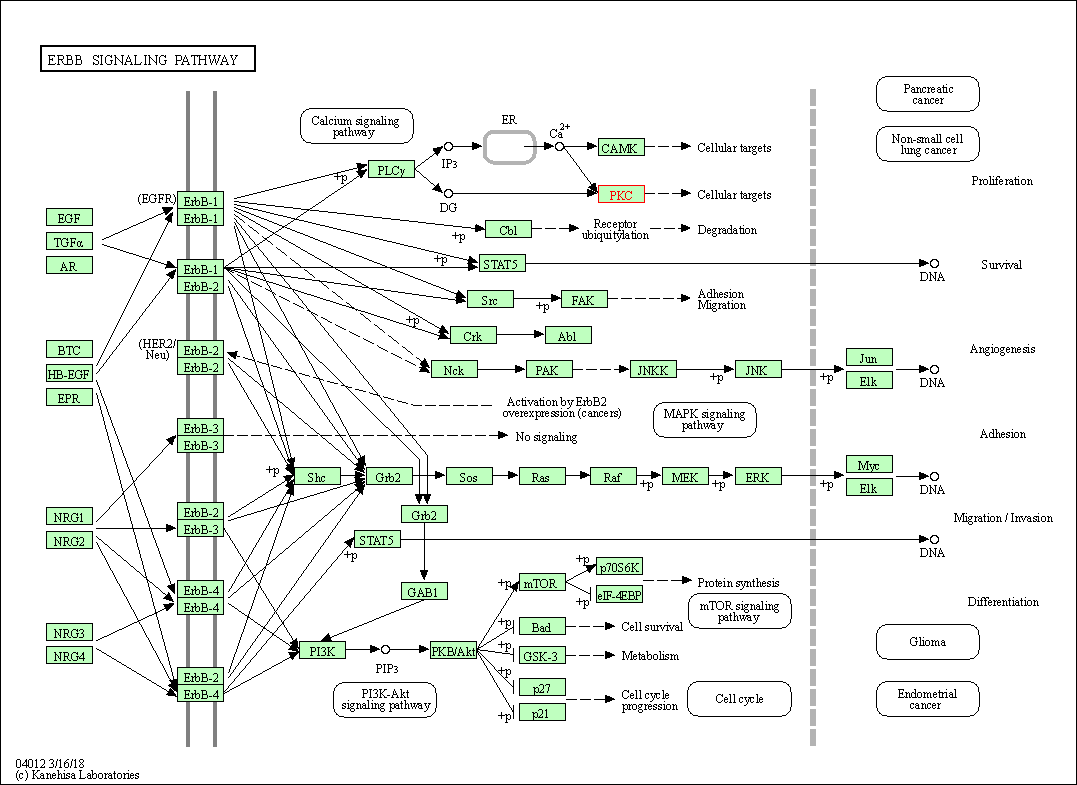
|
| Class: Environmental Information Processing => Signal transduction | Pathway Hierarchy | ||
| Ras signaling pathway | hsa04014 | Affiliated Target |

|
| Class: Environmental Information Processing => Signal transduction | Pathway Hierarchy | ||
| Rap1 signaling pathway | hsa04015 | Affiliated Target |
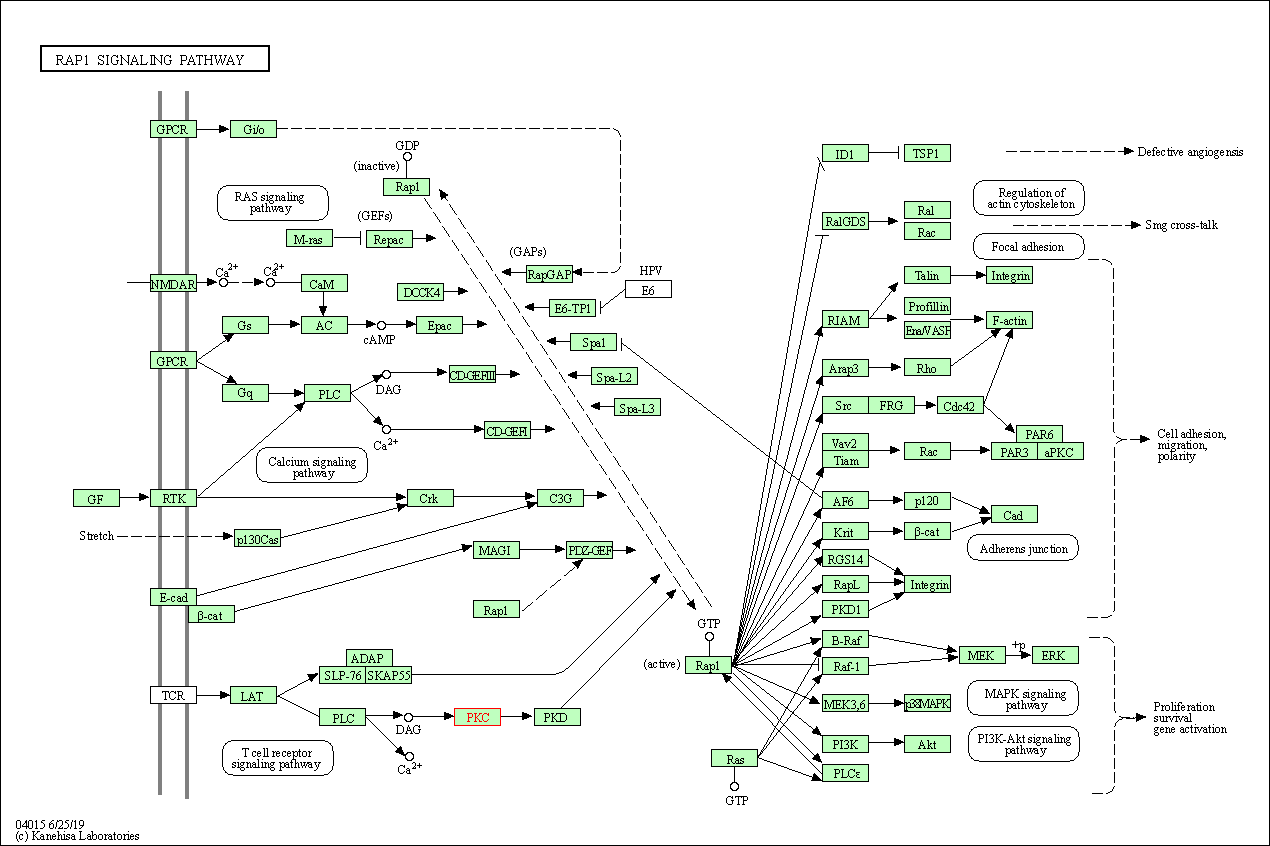
|
| Class: Environmental Information Processing => Signal transduction | Pathway Hierarchy | ||
| Calcium signaling pathway | hsa04020 | Affiliated Target |
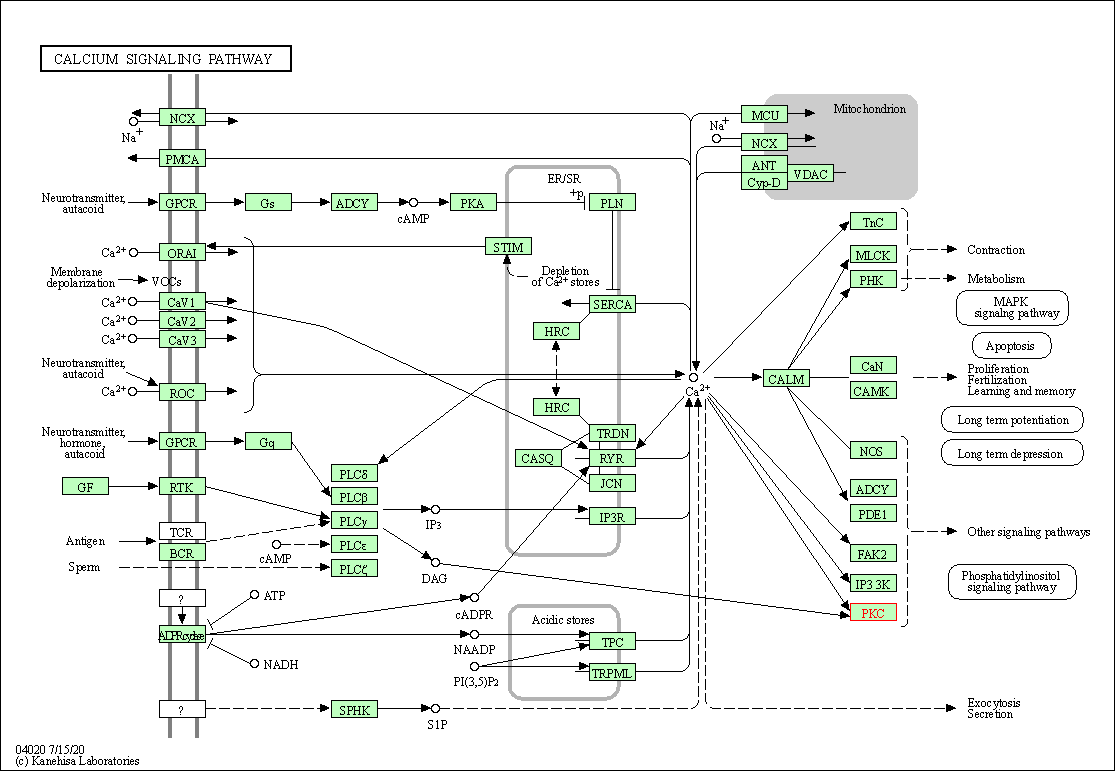
|
| Class: Environmental Information Processing => Signal transduction | Pathway Hierarchy | ||
| Chemokine signaling pathway | hsa04062 | Affiliated Target |
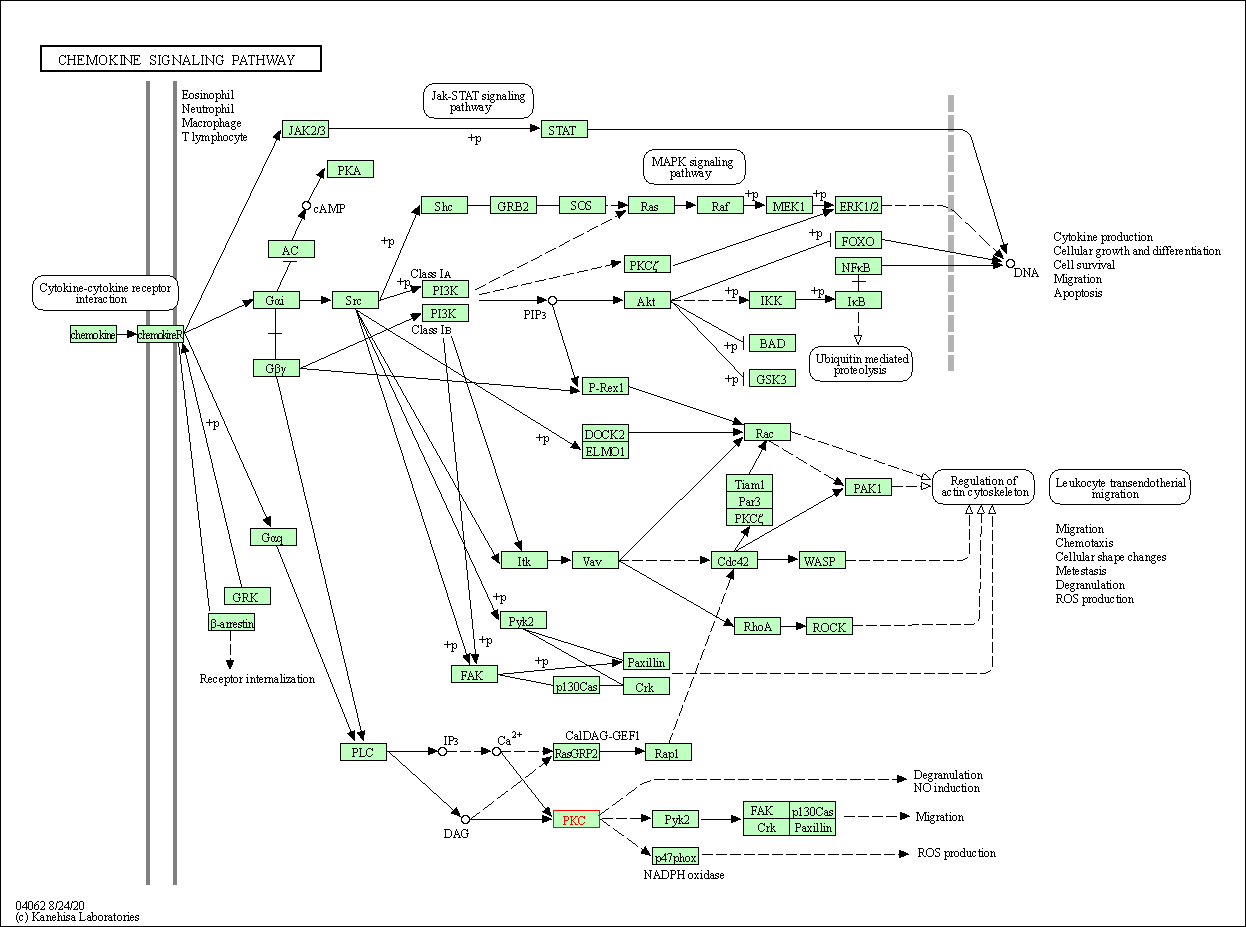
|
| Class: Organismal Systems => Immune system | Pathway Hierarchy | ||
| NF-kappa B signaling pathway | hsa04064 | Affiliated Target |
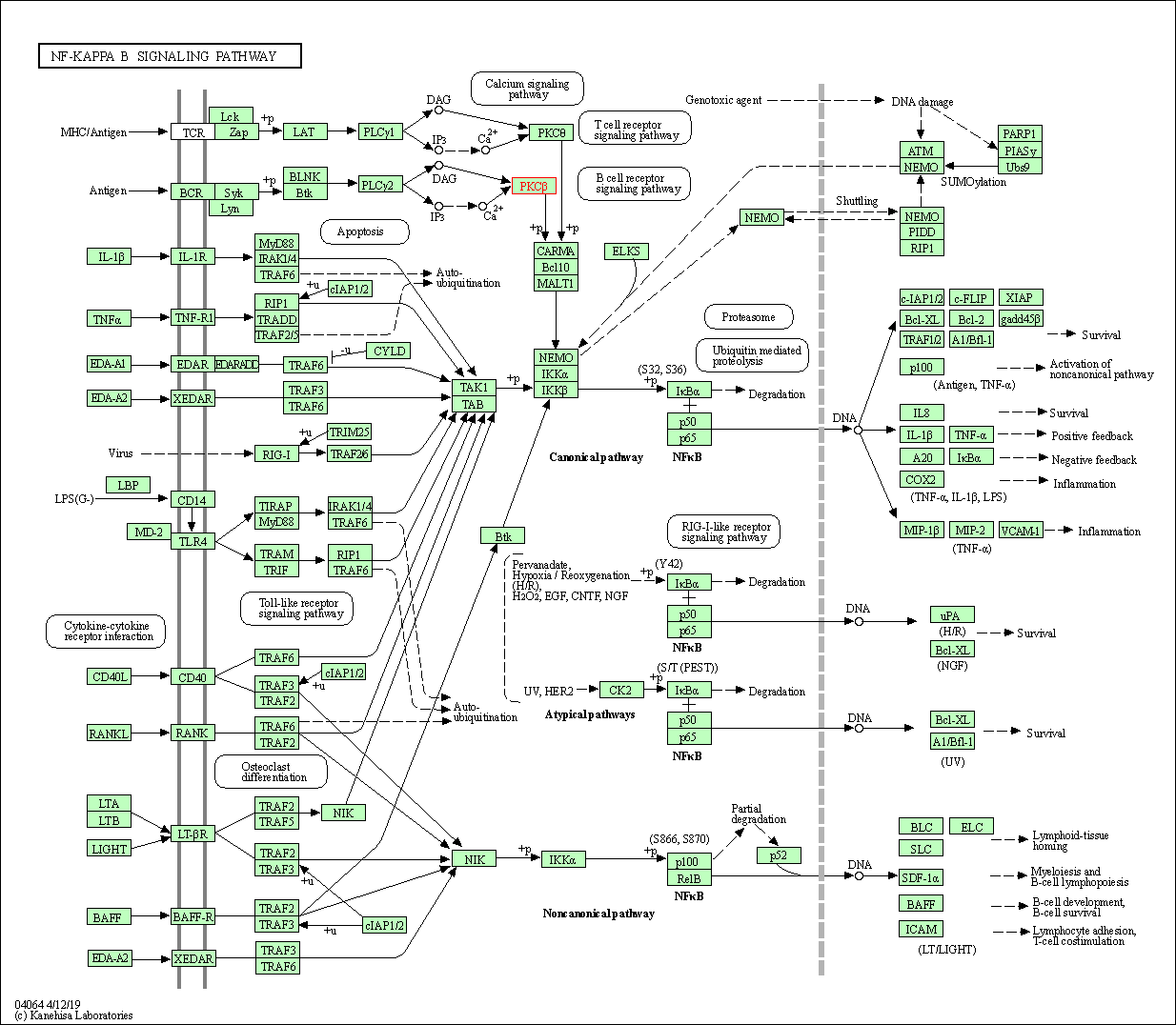
|
| Class: Environmental Information Processing => Signal transduction | Pathway Hierarchy | ||
| HIF-1 signaling pathway | hsa04066 | Affiliated Target |
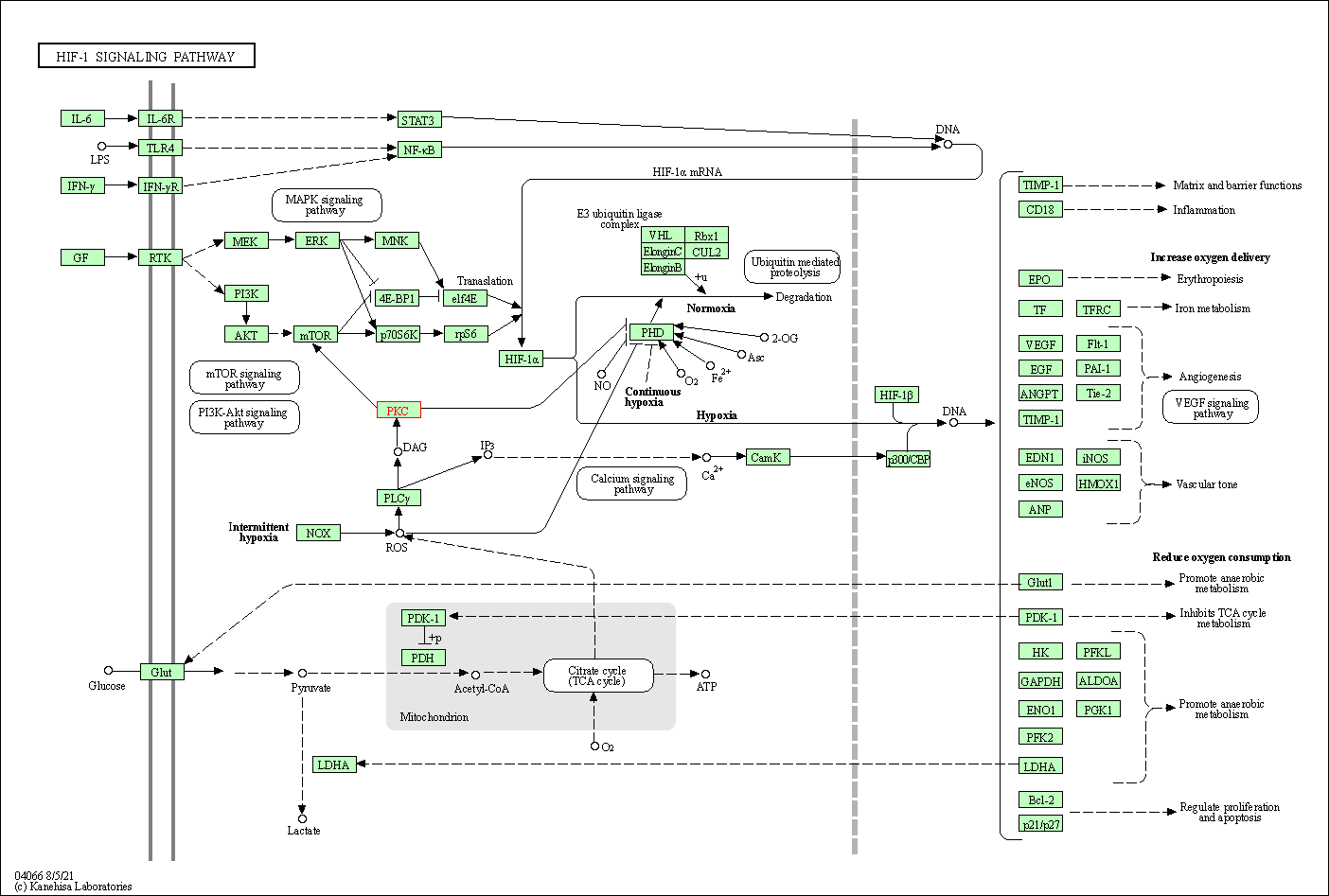
|
| Class: Environmental Information Processing => Signal transduction | Pathway Hierarchy | ||
| Phosphatidylinositol signaling system | hsa04070 | Affiliated Target |
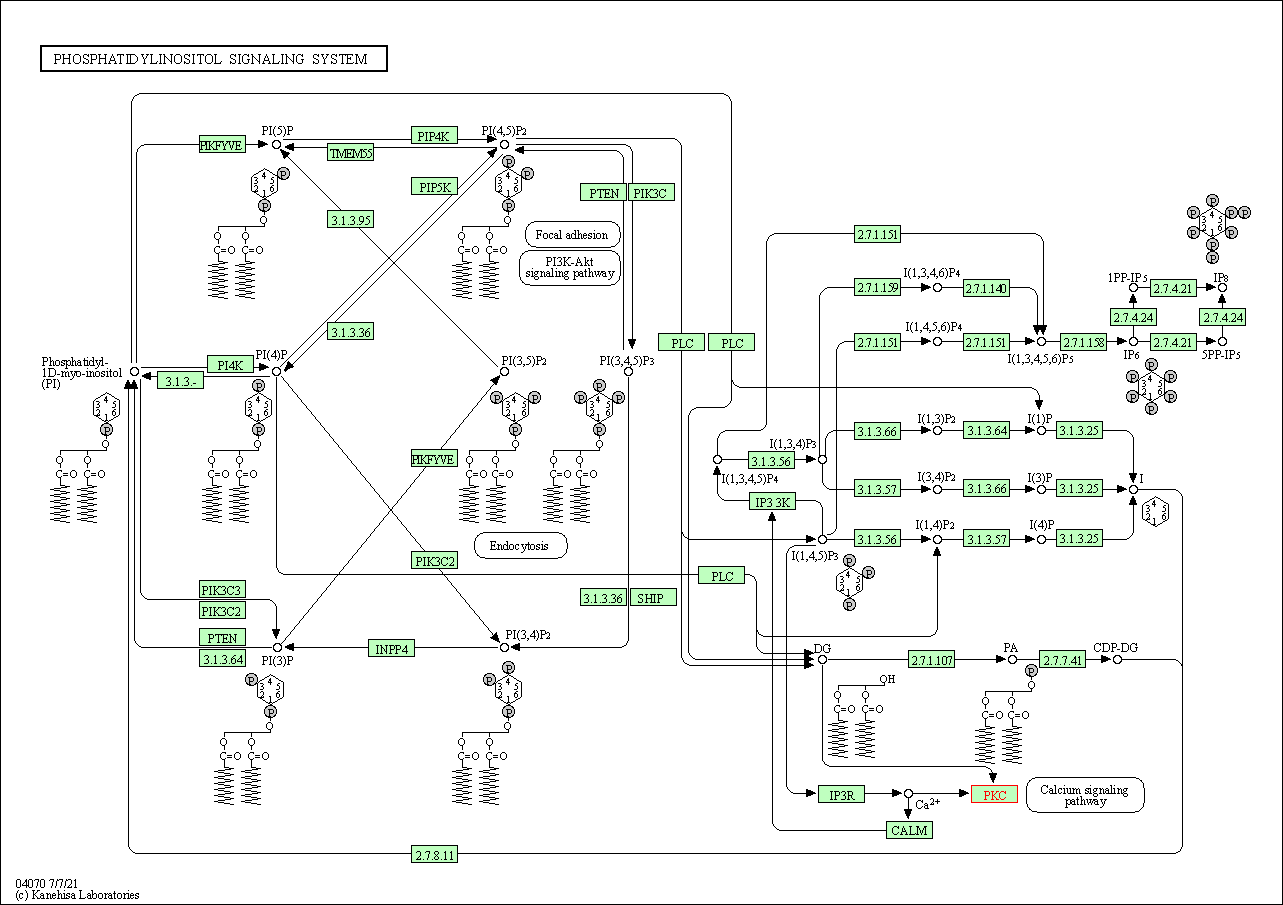
|
| Class: Environmental Information Processing => Signal transduction | Pathway Hierarchy | ||
| Sphingolipid signaling pathway | hsa04071 | Affiliated Target |
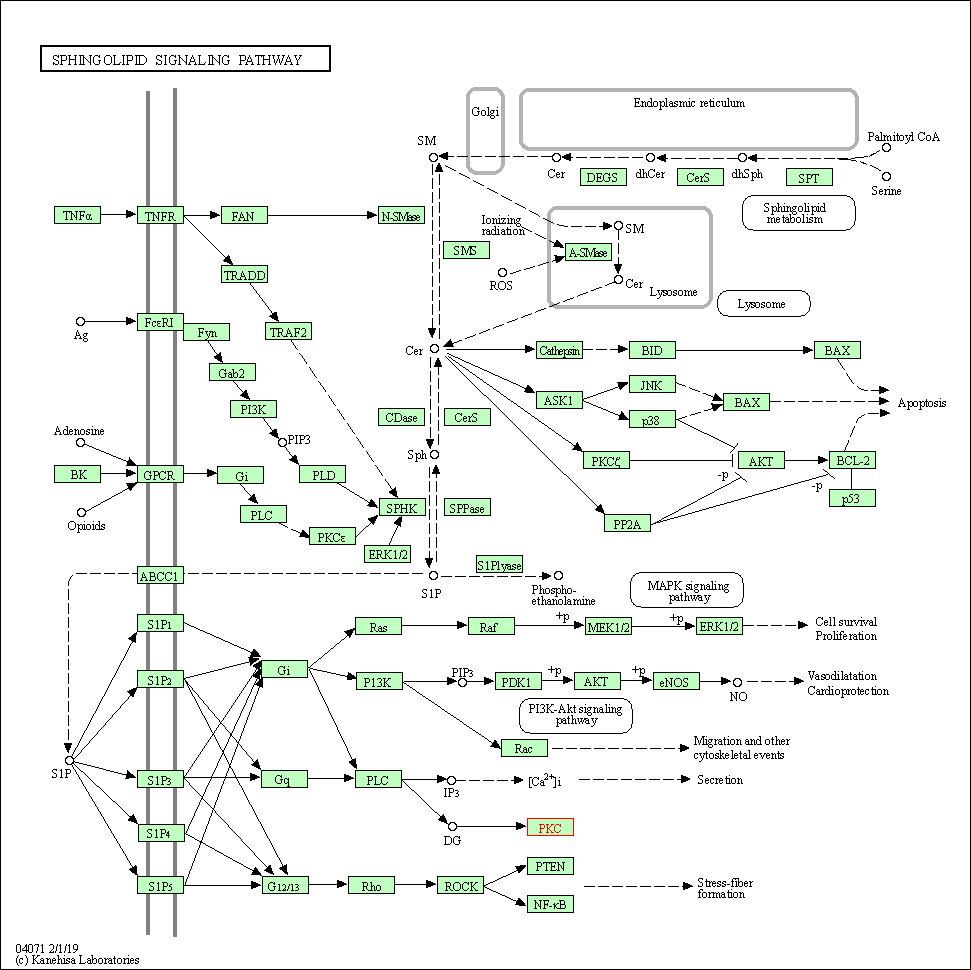
|
| Class: Environmental Information Processing => Signal transduction | Pathway Hierarchy | ||
| mTOR signaling pathway | hsa04150 | Affiliated Target |
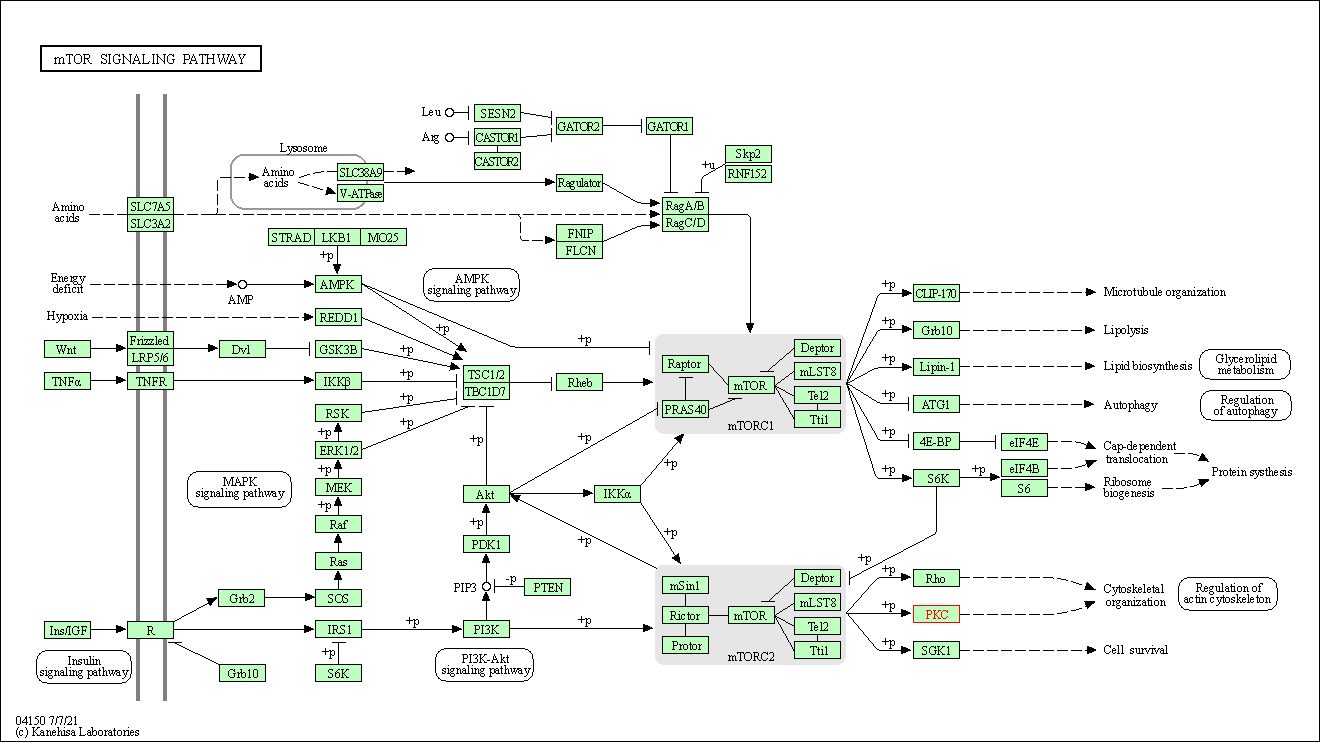
|
| Class: Environmental Information Processing => Signal transduction | Pathway Hierarchy | ||
| Vascular smooth muscle contraction | hsa04270 | Affiliated Target |
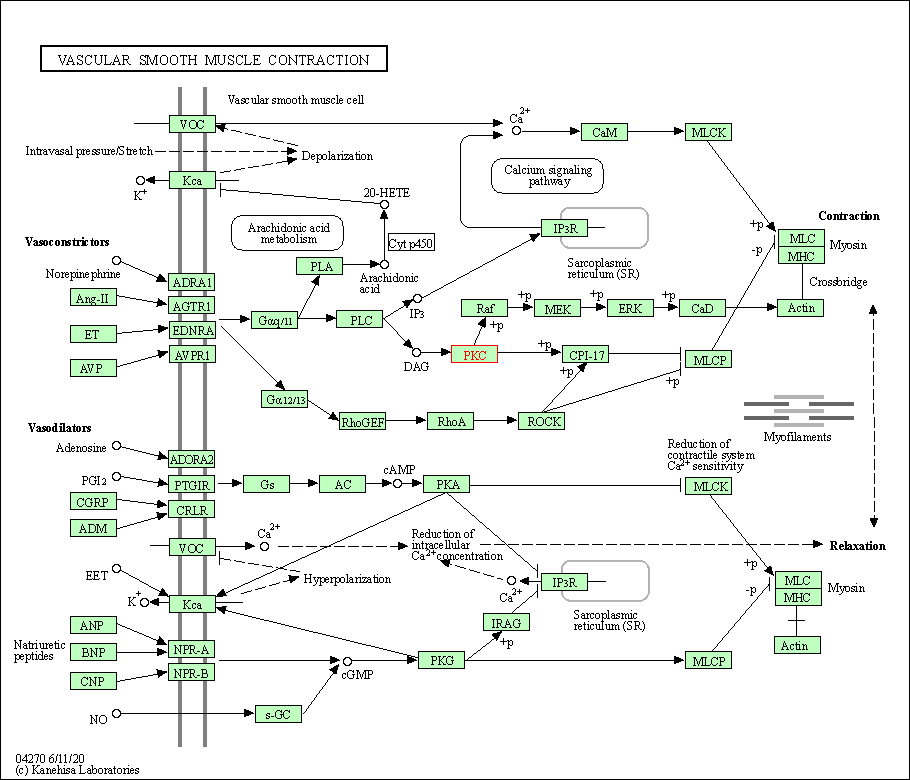
|
| Class: Organismal Systems => Circulatory system | Pathway Hierarchy | ||
| Wnt signaling pathway | hsa04310 | Affiliated Target |
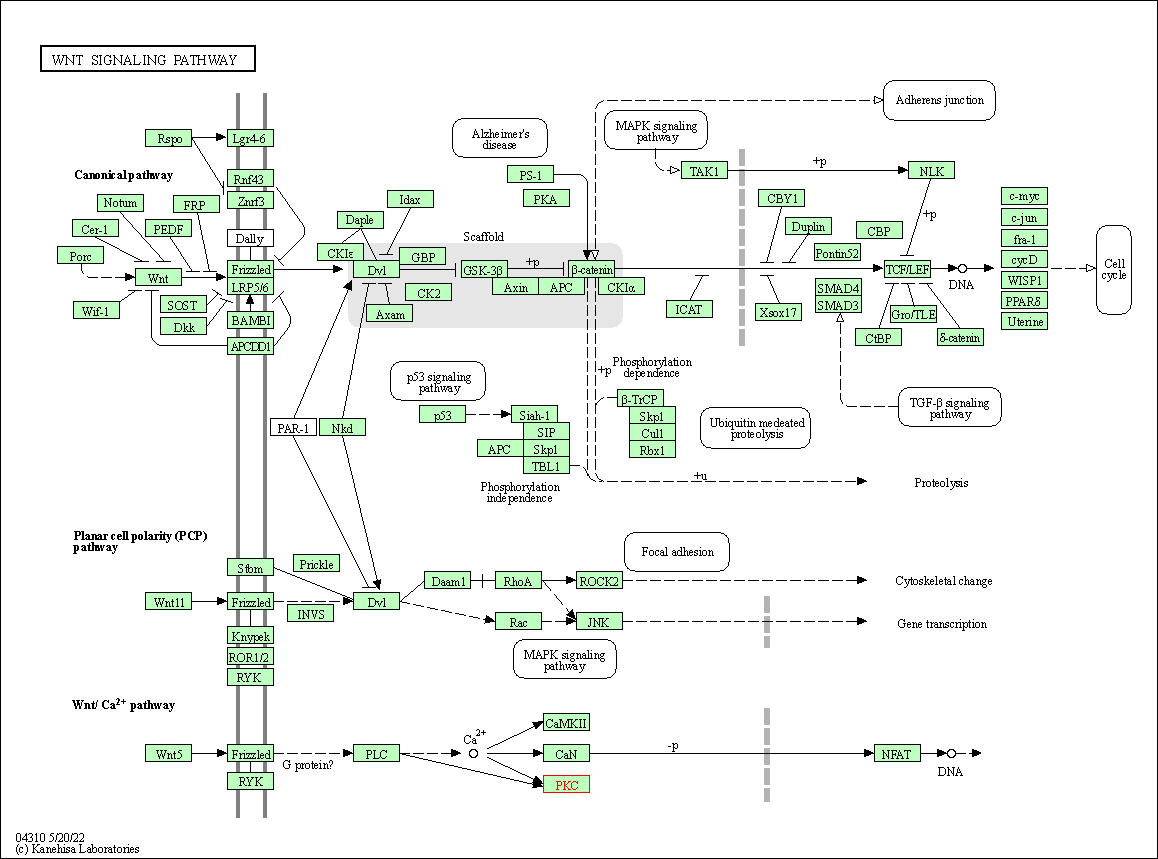
|
| Class: Environmental Information Processing => Signal transduction | Pathway Hierarchy | ||
| VEGF signaling pathway | hsa04370 | Affiliated Target |
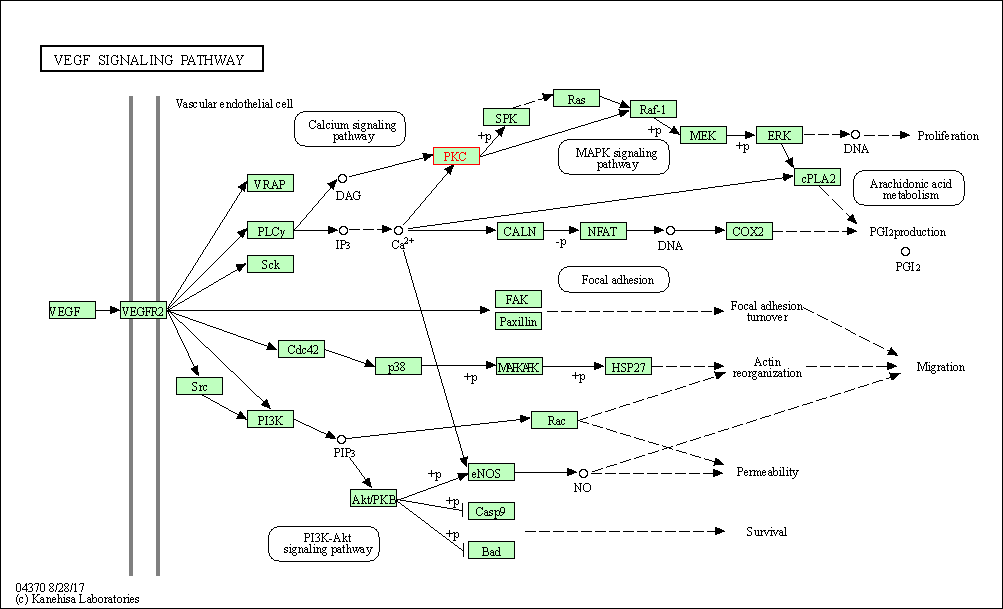
|
| Class: Environmental Information Processing => Signal transduction | Pathway Hierarchy | ||
| Focal adhesion | hsa04510 | Affiliated Target |
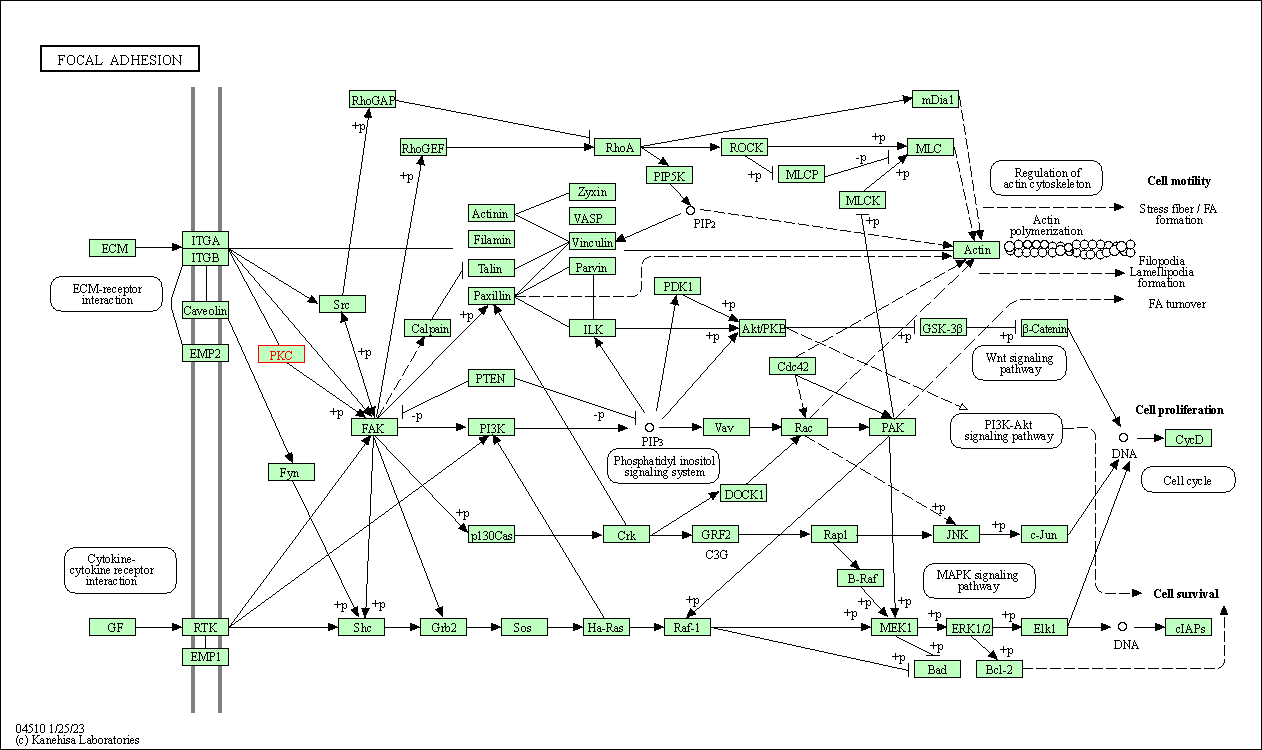
|
| Class: Cellular Processes => Cellular community - eukaryotes | Pathway Hierarchy | ||
| Gap junction | hsa04540 | Affiliated Target |
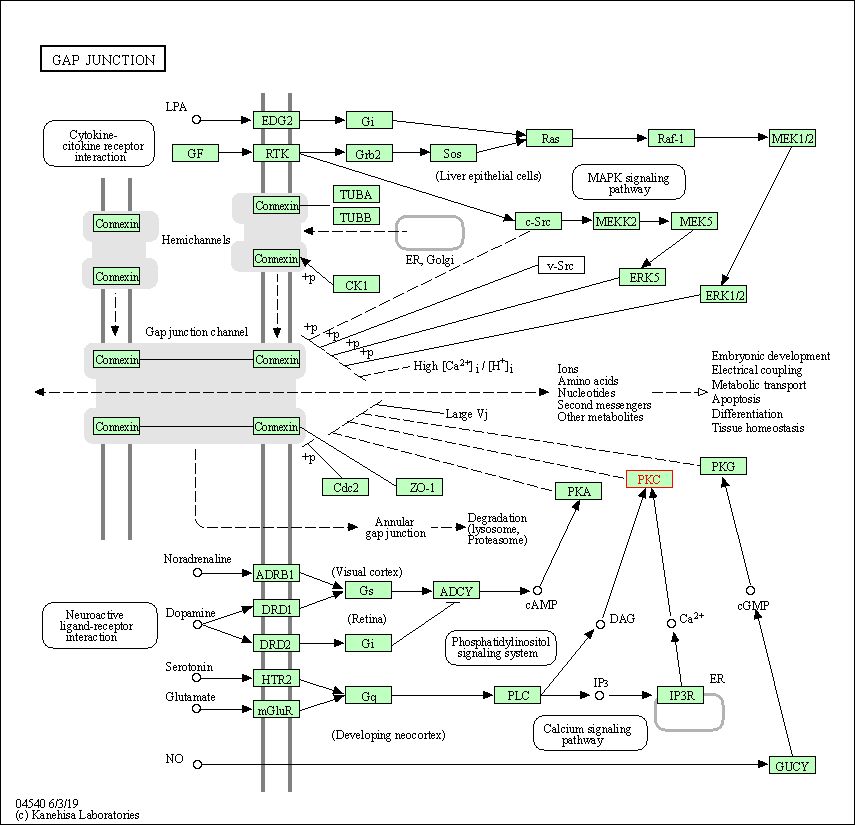
|
| Class: Cellular Processes => Cellular community - eukaryotes | Pathway Hierarchy | ||
| Neutrophil extracellular trap formation | hsa04613 | Affiliated Target |
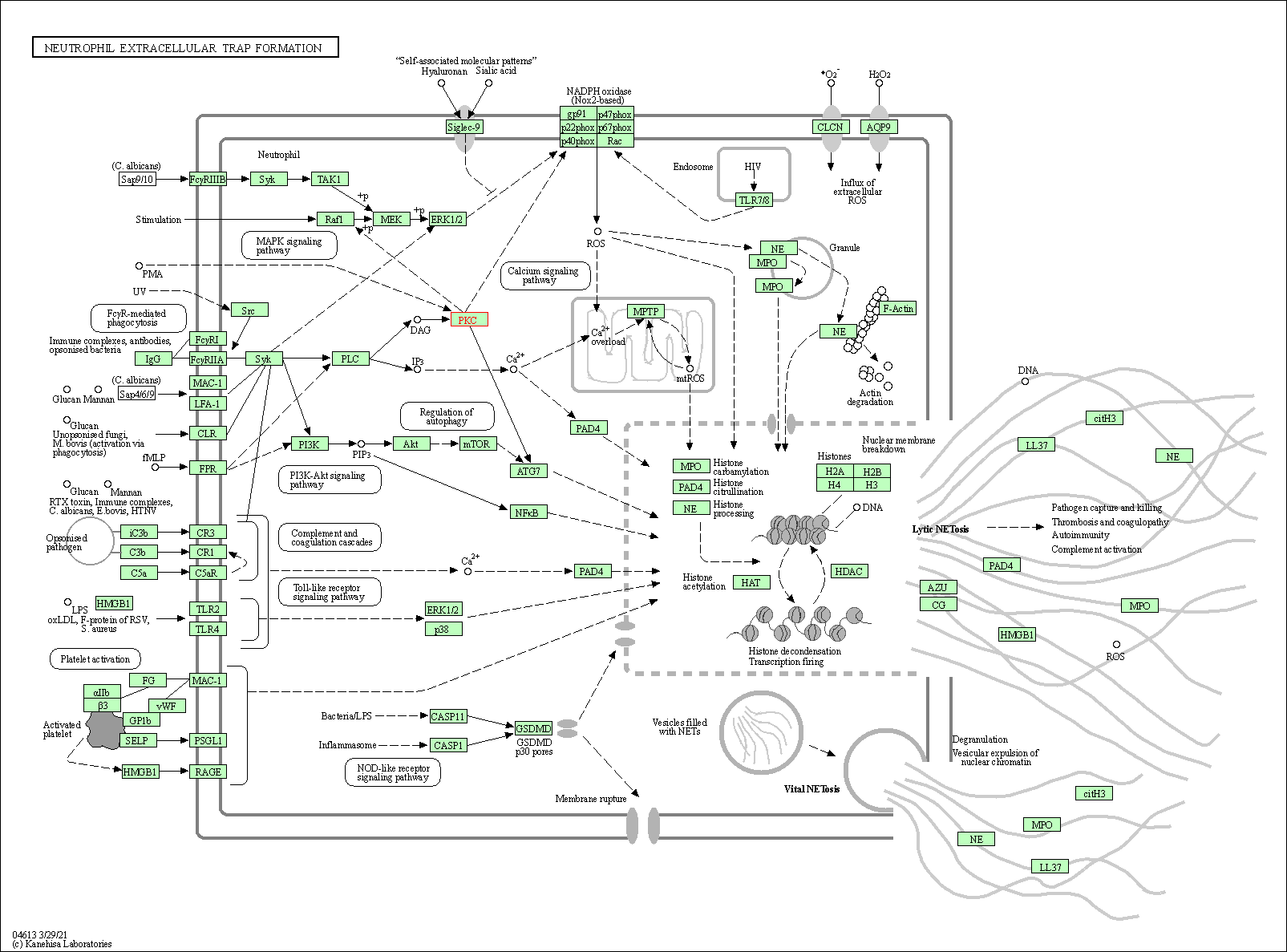
|
| Class: Organismal Systems => Immune system | Pathway Hierarchy | ||
| Natural killer cell mediated cytotoxicity | hsa04650 | Affiliated Target |

|
| Class: Organismal Systems => Immune system | Pathway Hierarchy | ||
| B cell receptor signaling pathway | hsa04662 | Affiliated Target |
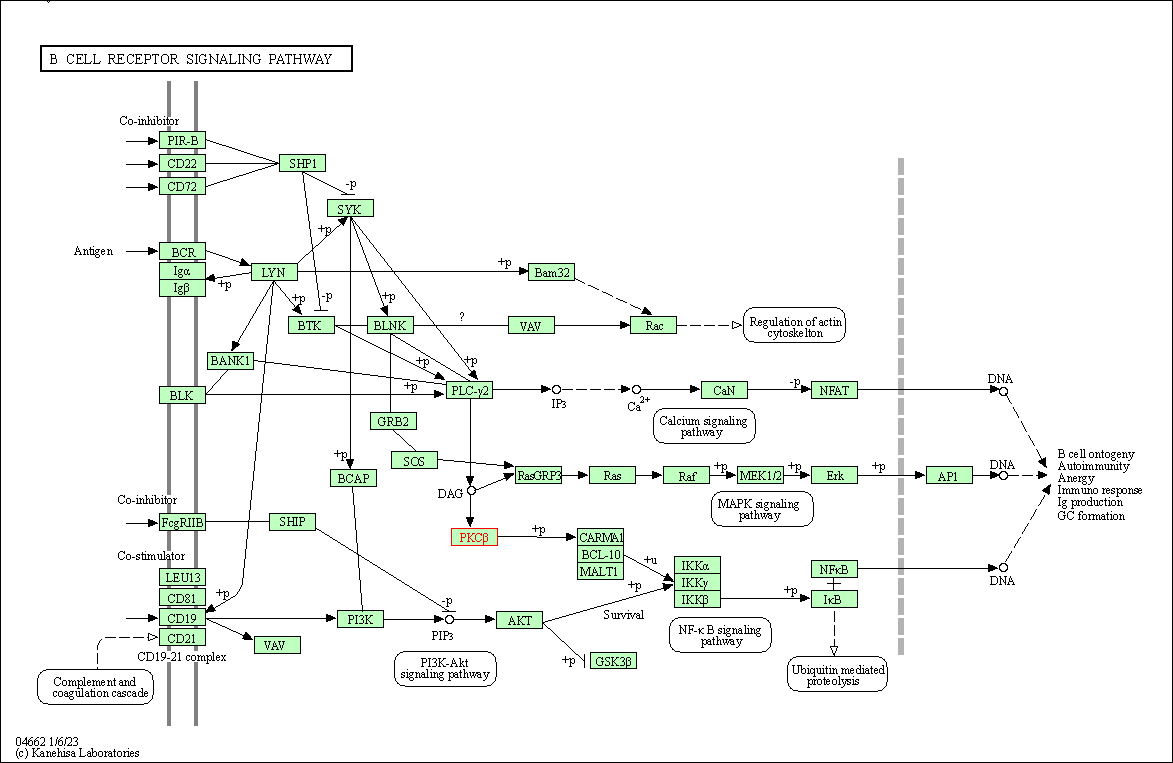
|
| Class: Organismal Systems => Immune system | Pathway Hierarchy | ||
| Fc gamma R-mediated phagocytosis | hsa04666 | Affiliated Target |
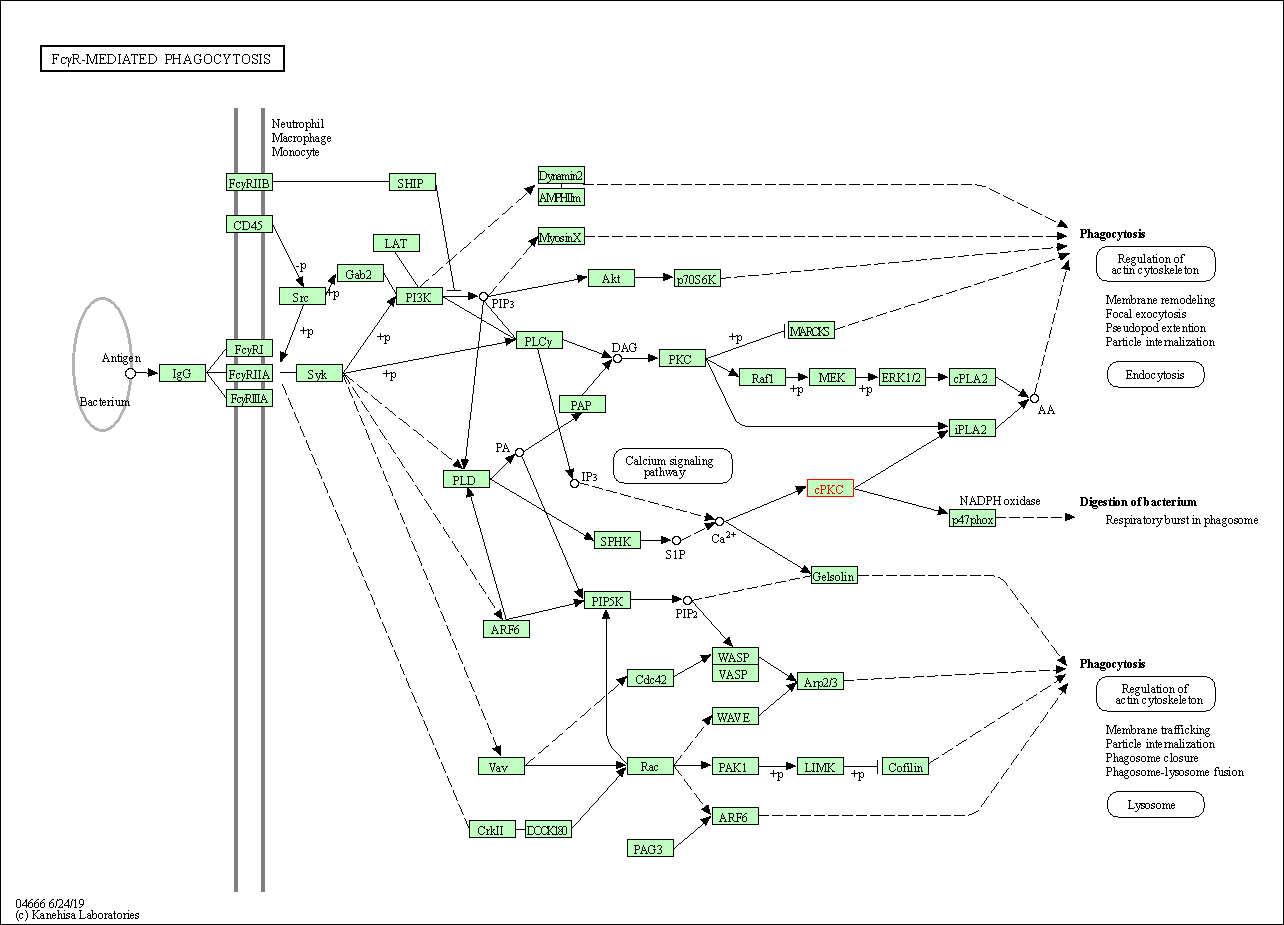
|
| Class: Organismal Systems => Immune system | Pathway Hierarchy | ||
| Leukocyte transendothelial migration | hsa04670 | Affiliated Target |
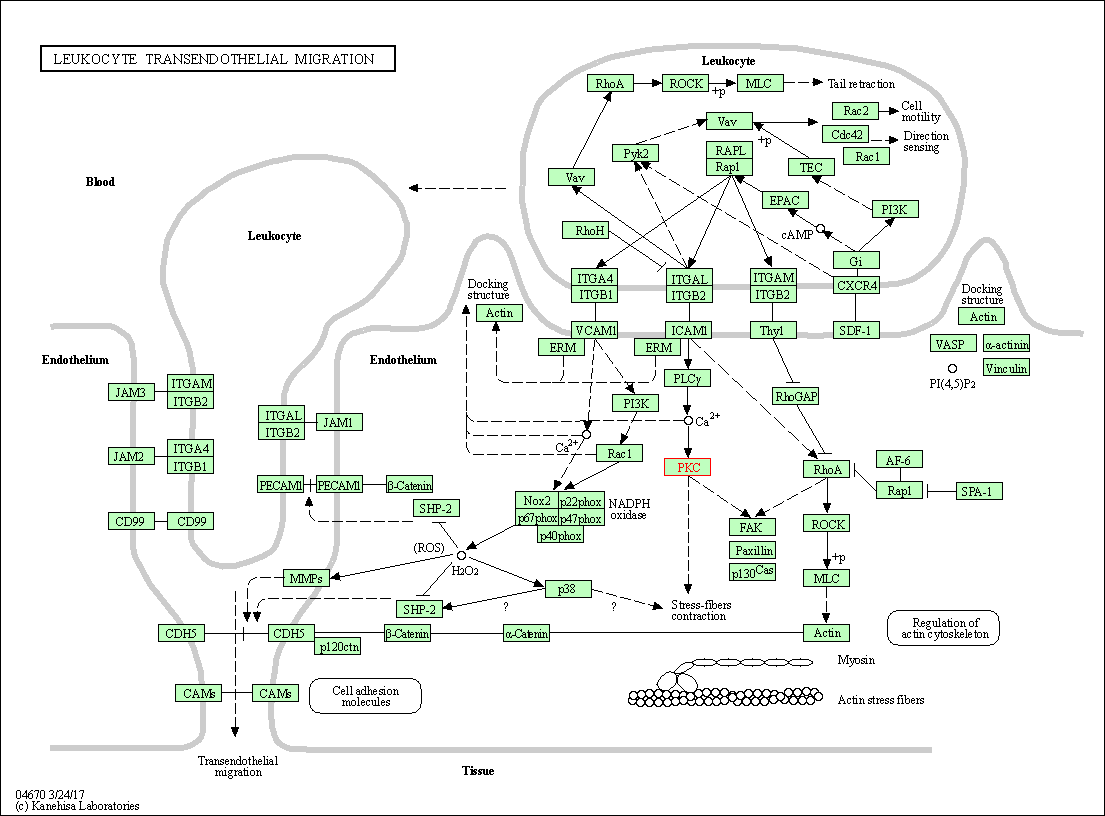
|
| Class: Organismal Systems => Immune system | Pathway Hierarchy | ||
| Circadian entrainment | hsa04713 | Affiliated Target |

|
| Class: Organismal Systems => Environmental adaptation | Pathway Hierarchy | ||
| Long-term potentiation | hsa04720 | Affiliated Target |
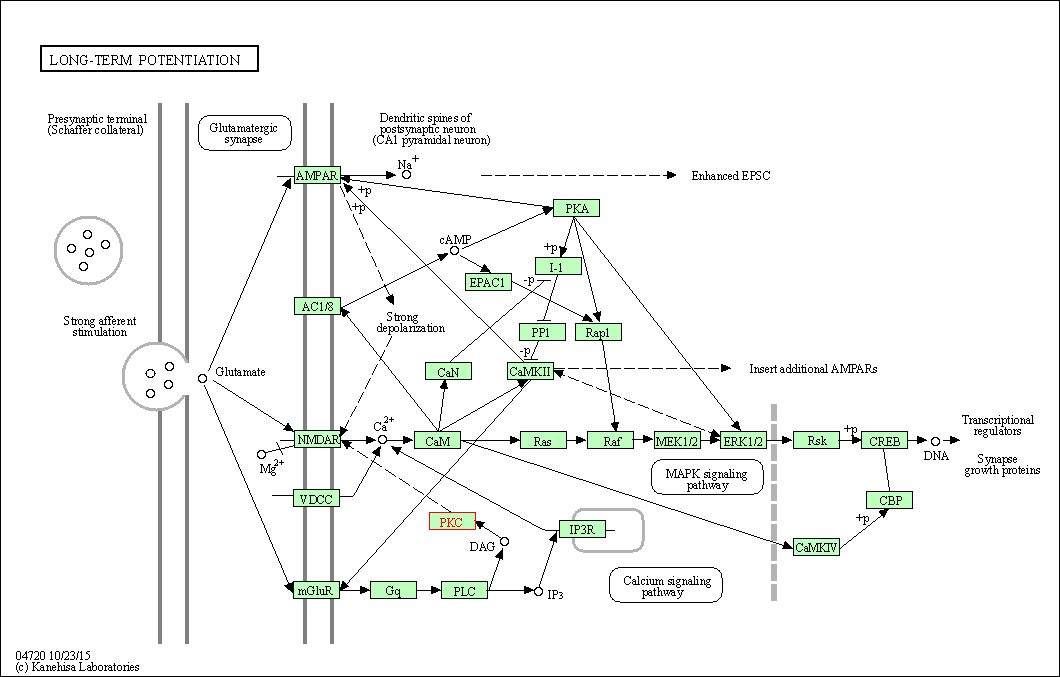
|
| Class: Organismal Systems => Nervous system | Pathway Hierarchy | ||
| Retrograde endocannabinoid signaling | hsa04723 | Affiliated Target |

|
| Class: Organismal Systems => Nervous system | Pathway Hierarchy | ||
| Glutamatergic synapse | hsa04724 | Affiliated Target |
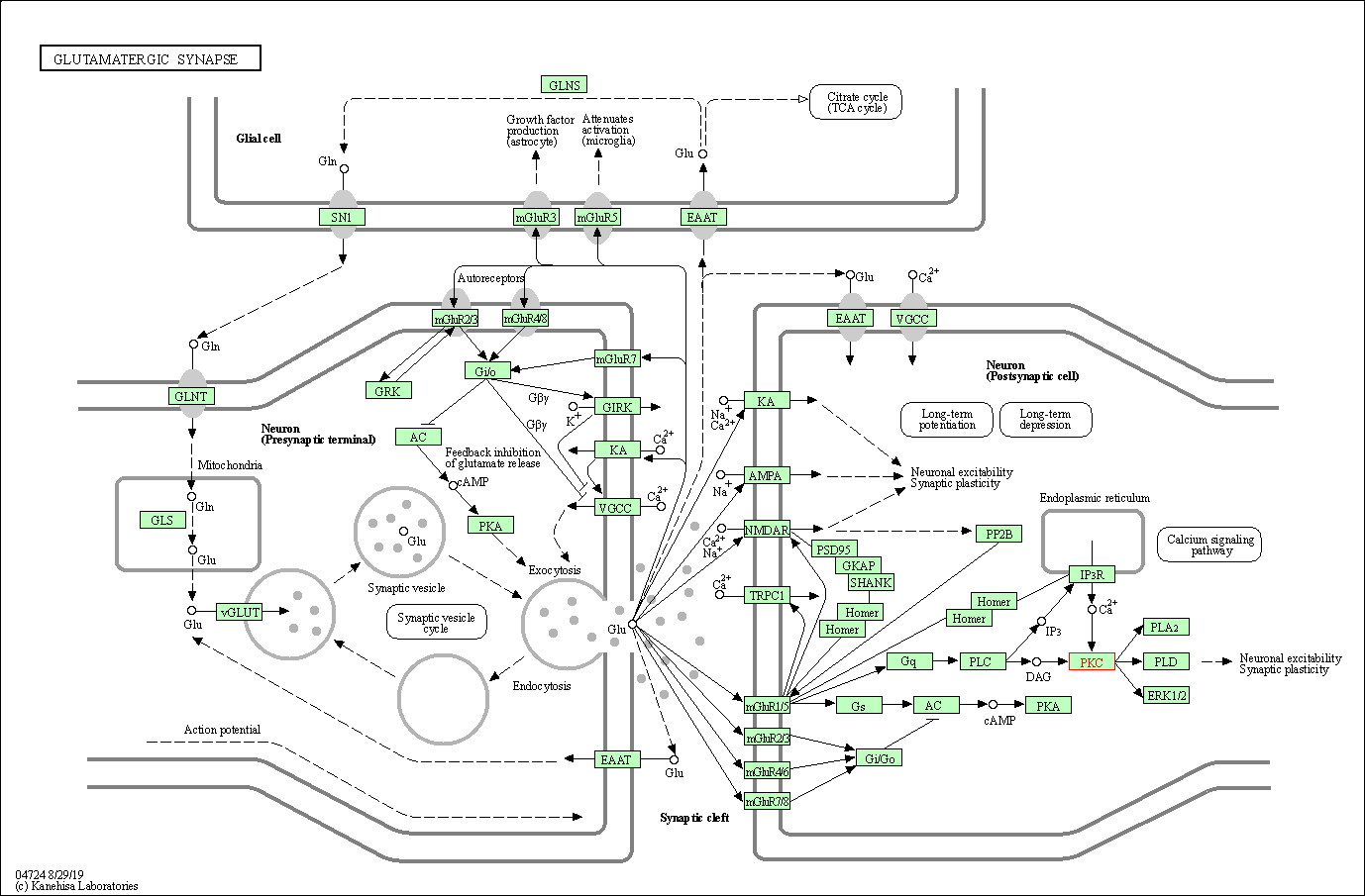
|
| Class: Organismal Systems => Nervous system | Pathway Hierarchy | ||
| Cholinergic synapse | hsa04725 | Affiliated Target |
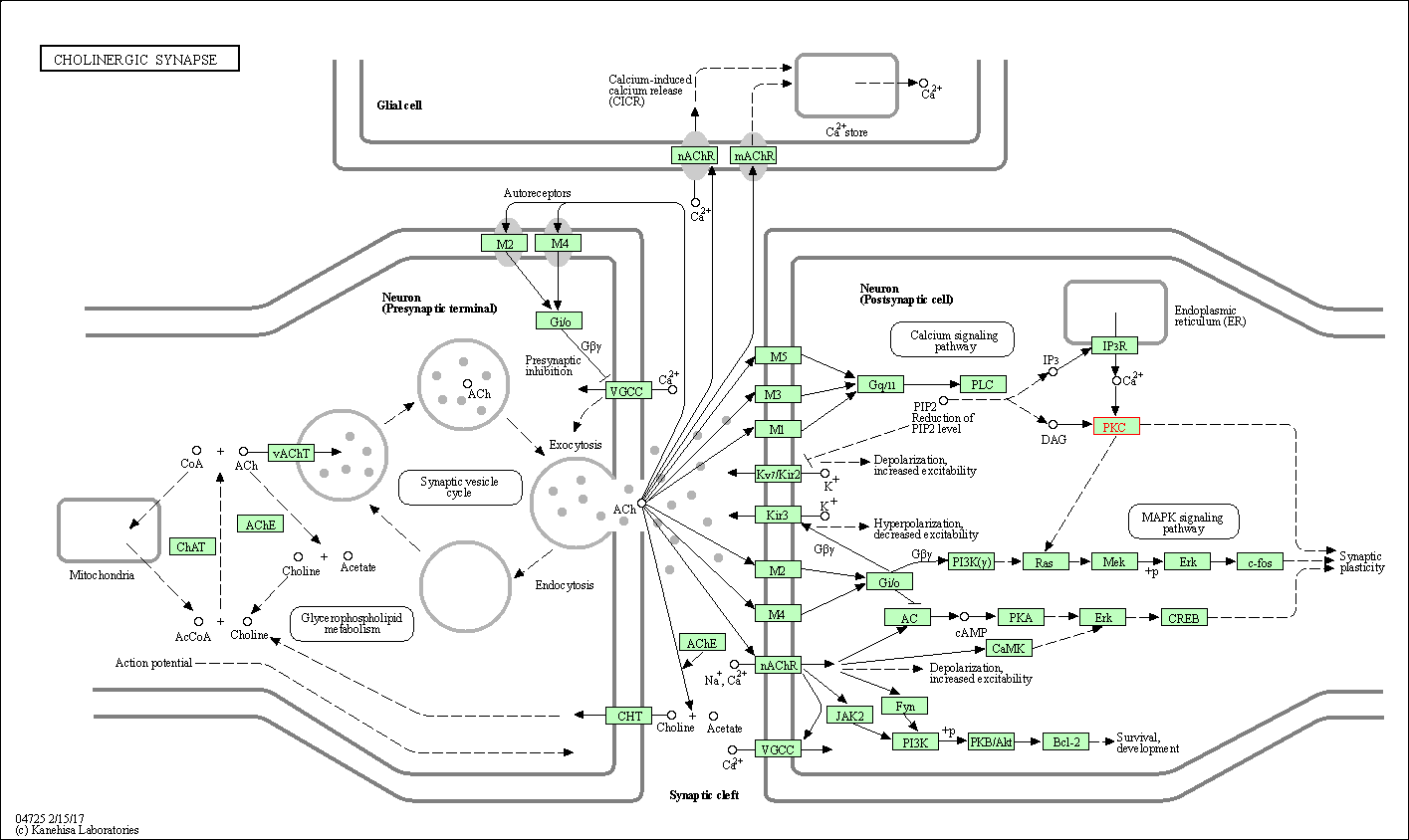
|
| Class: Organismal Systems => Nervous system | Pathway Hierarchy | ||
| Serotonergic synapse | hsa04726 | Affiliated Target |
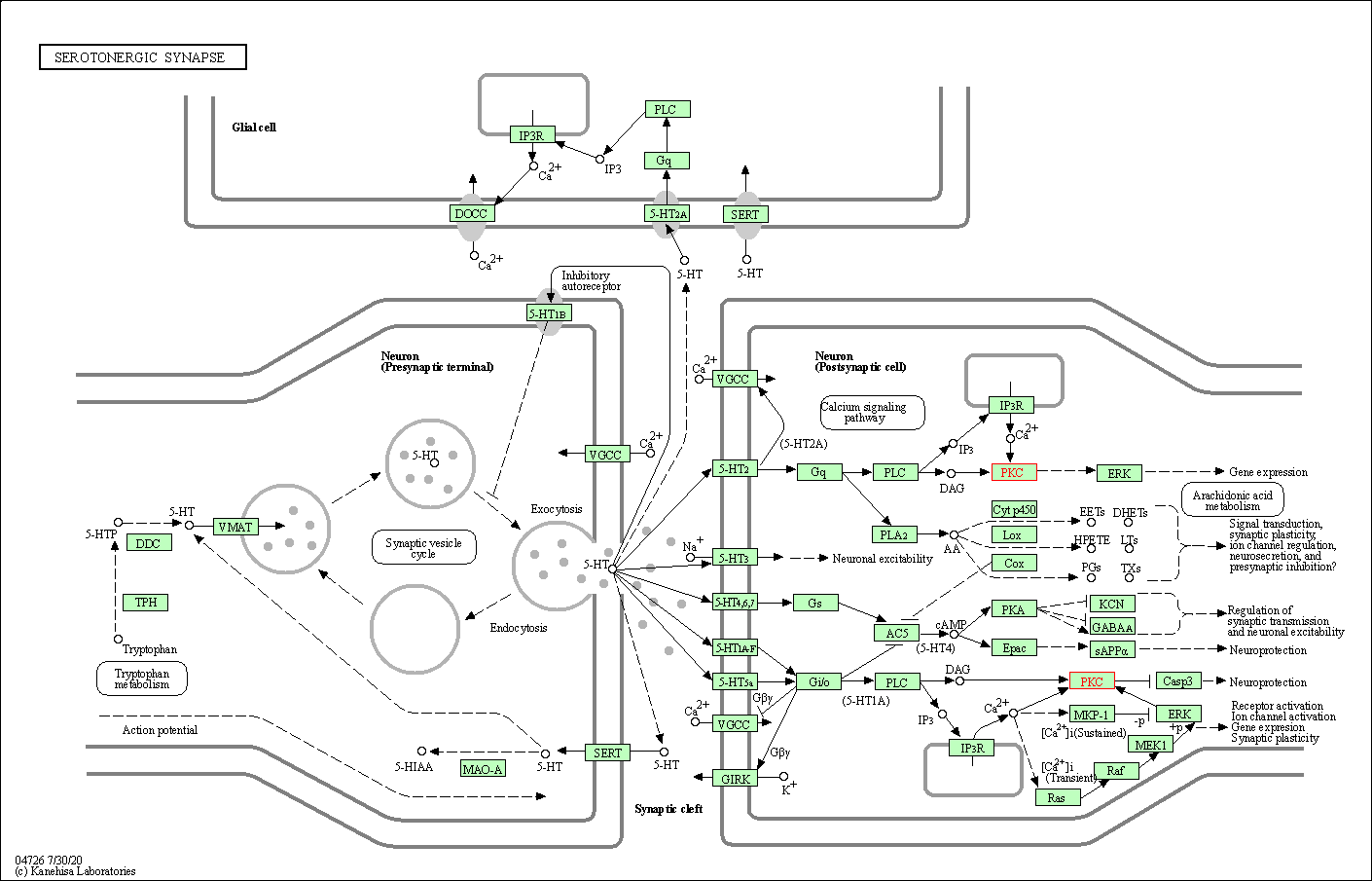
|
| Class: Organismal Systems => Nervous system | Pathway Hierarchy | ||
| GABAergic synapse | hsa04727 | Affiliated Target |
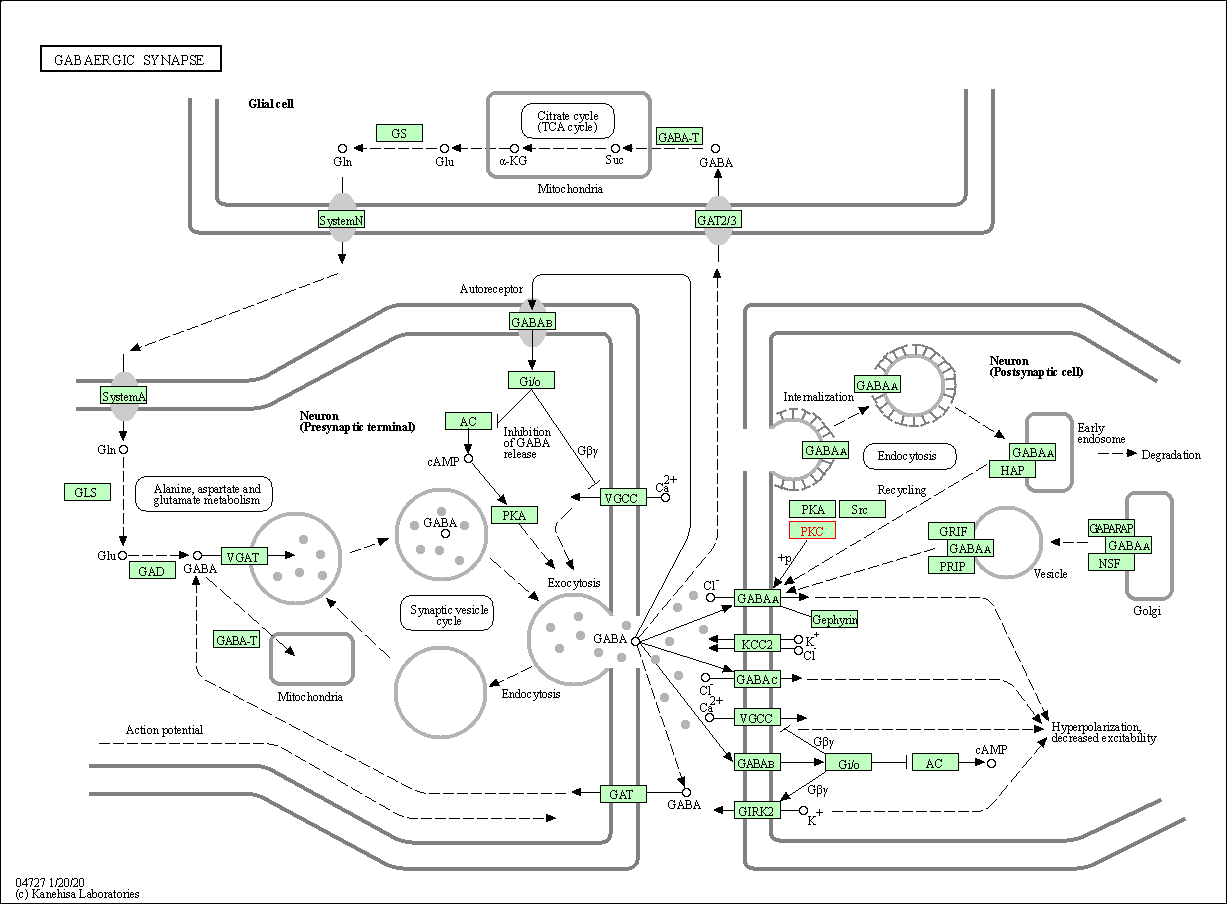
|
| Class: Organismal Systems => Nervous system | Pathway Hierarchy | ||
| Dopaminergic synapse | hsa04728 | Affiliated Target |
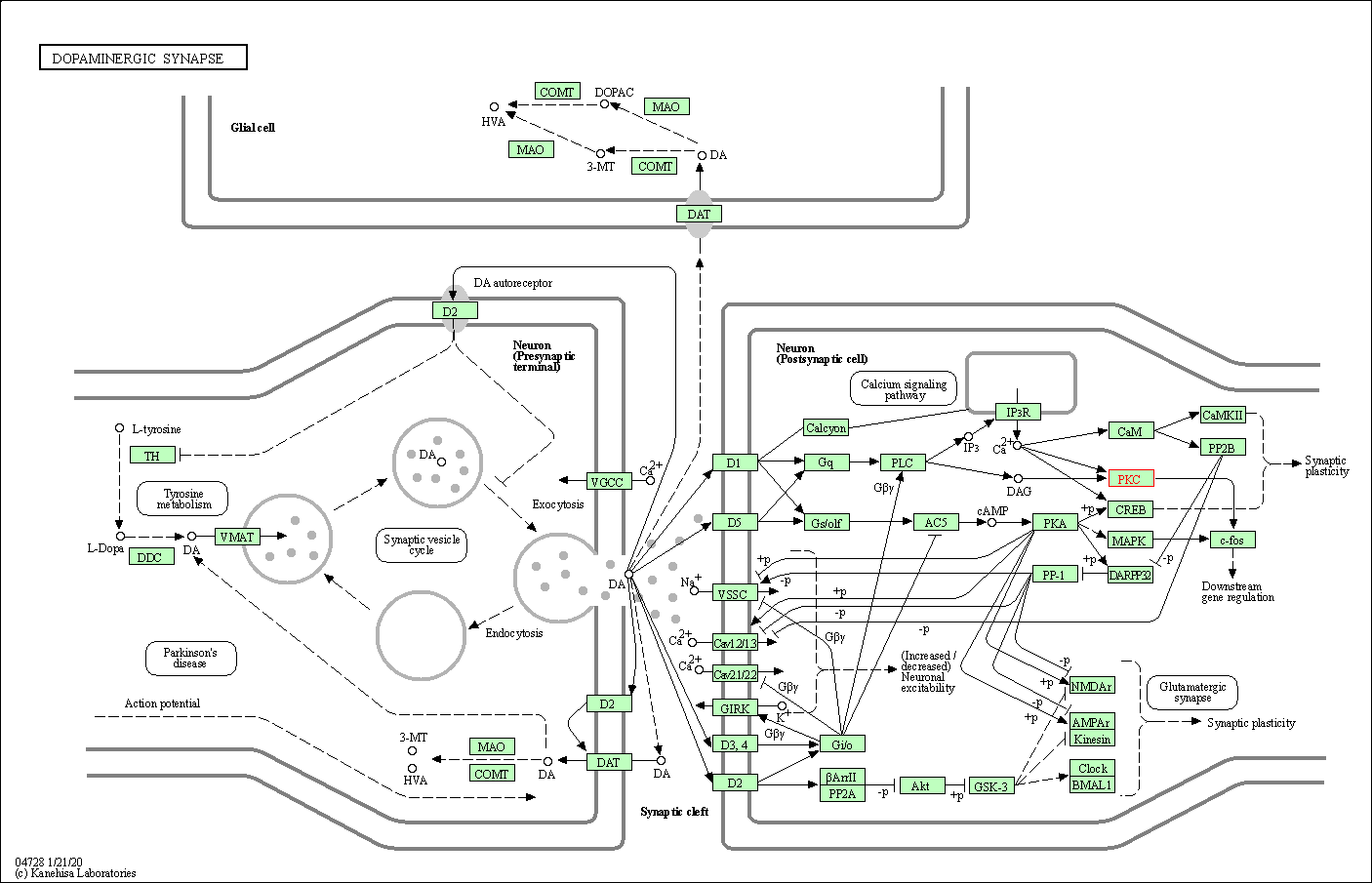
|
| Class: Organismal Systems => Nervous system | Pathway Hierarchy | ||
| Long-term depression | hsa04730 | Affiliated Target |
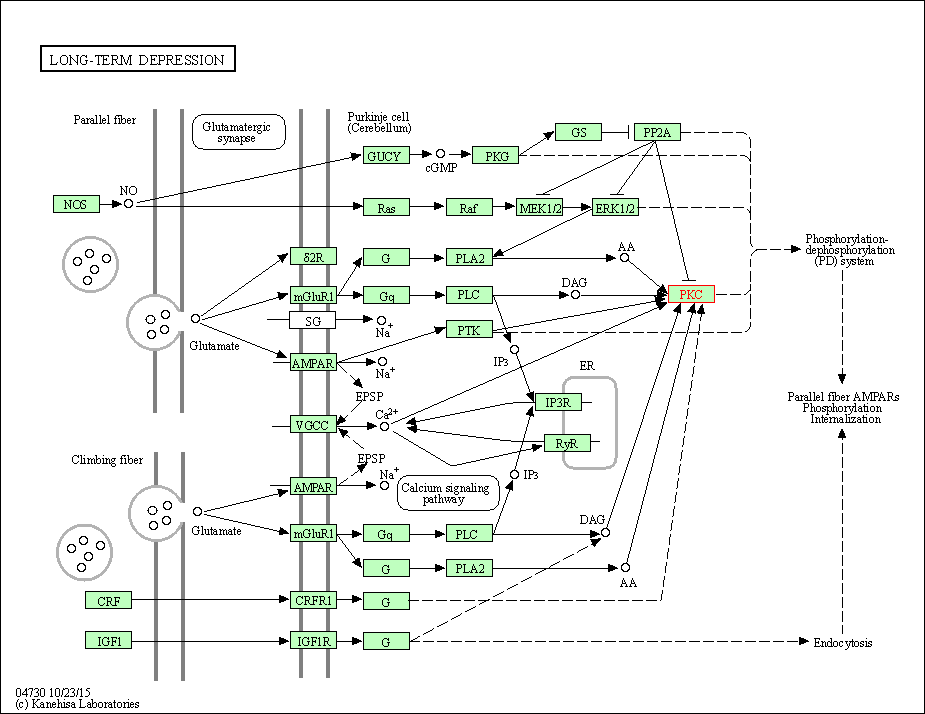
|
| Class: Organismal Systems => Nervous system | Pathway Hierarchy | ||
| Inflammatory mediator regulation of TRP channels | hsa04750 | Affiliated Target |
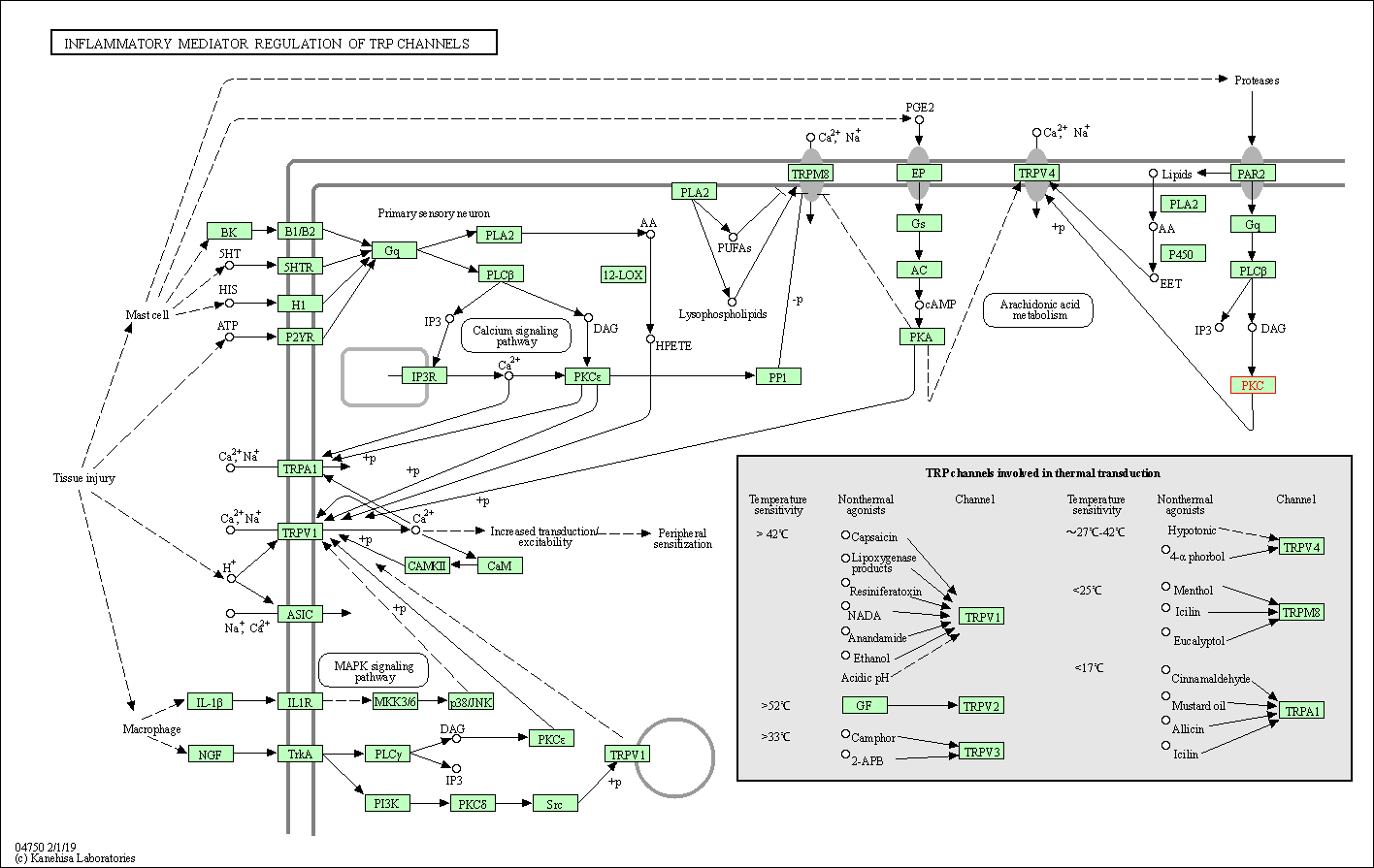
|
| Class: Organismal Systems => Sensory system | Pathway Hierarchy | ||
| Insulin secretion | hsa04911 | Affiliated Target |
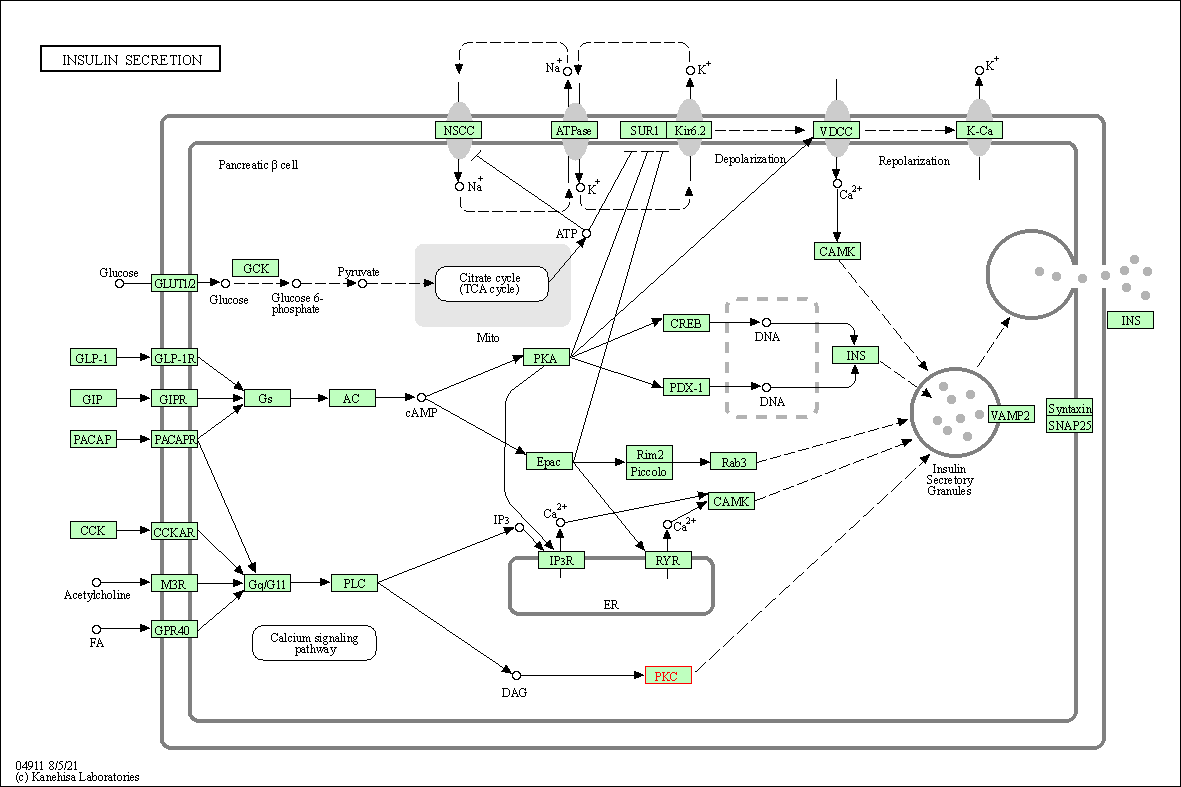
|
| Class: Organismal Systems => Endocrine system | Pathway Hierarchy | ||
| GnRH signaling pathway | hsa04912 | Affiliated Target |

|
| Class: Organismal Systems => Endocrine system | Pathway Hierarchy | ||
| Melanogenesis | hsa04916 | Affiliated Target |
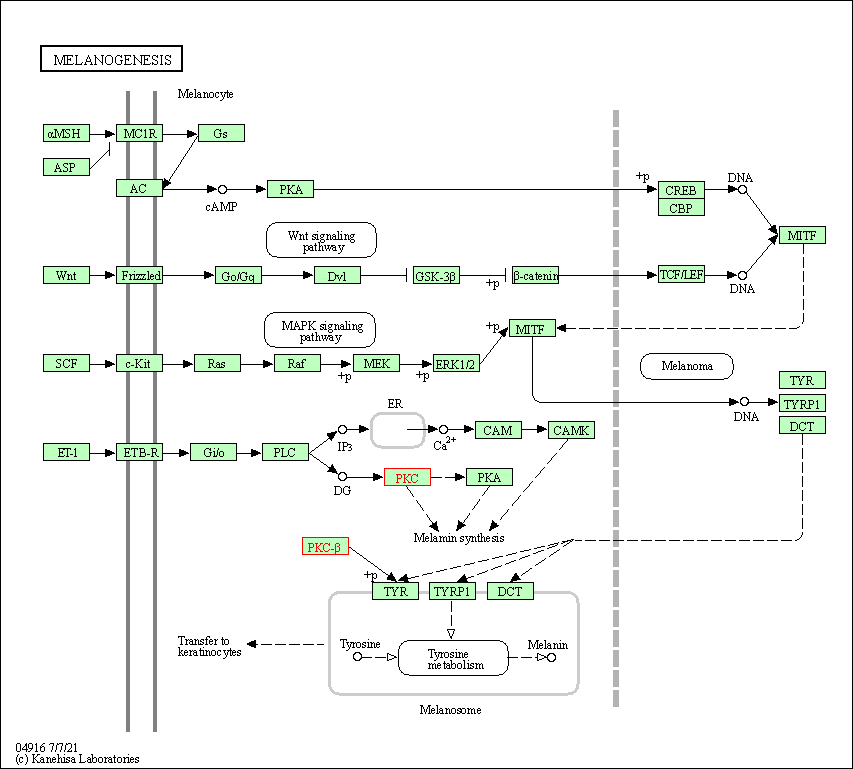
|
| Class: Organismal Systems => Endocrine system | Pathway Hierarchy | ||
| Thyroid hormone synthesis | hsa04918 | Affiliated Target |
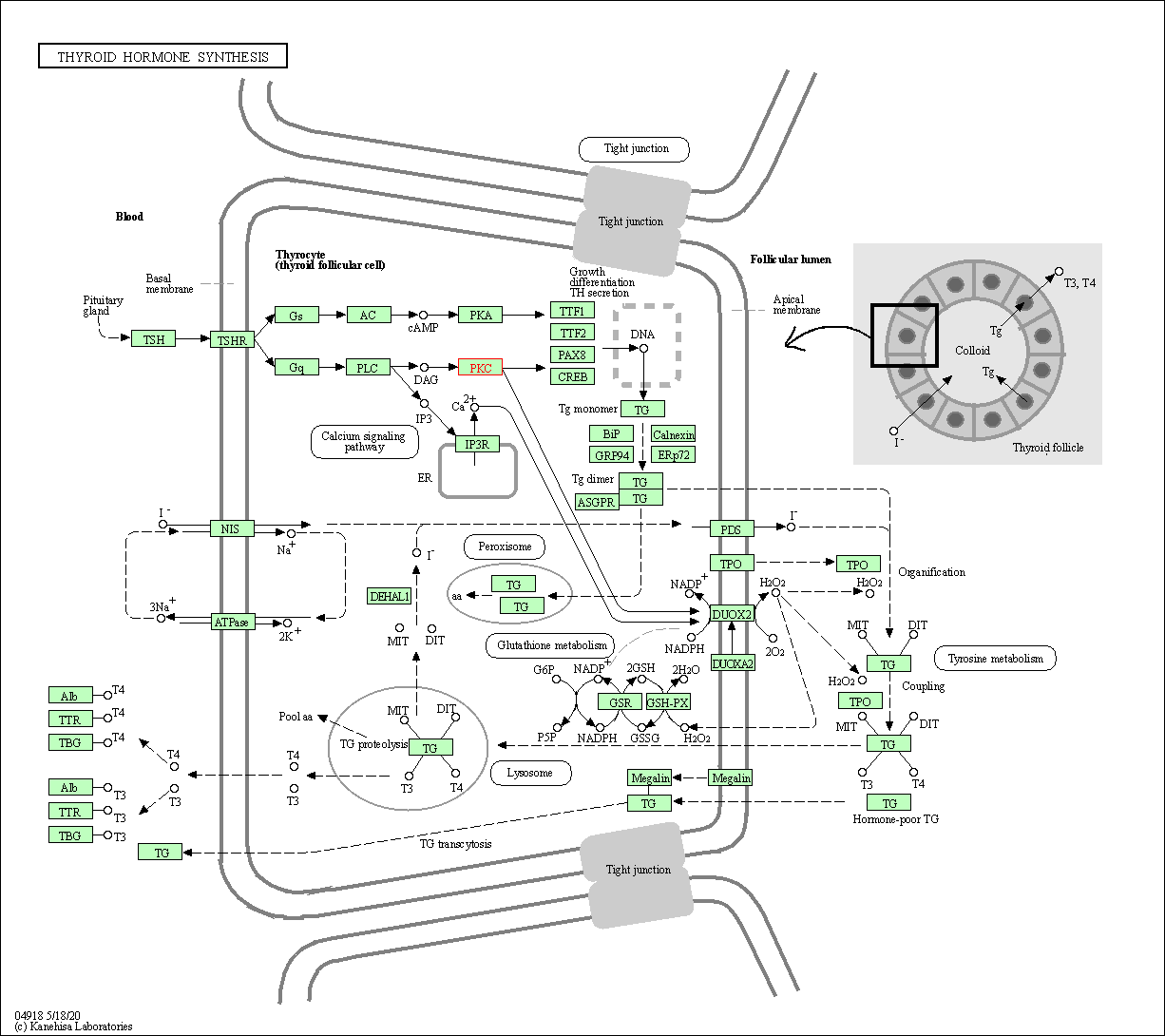
|
| Class: Organismal Systems => Endocrine system | Pathway Hierarchy | ||
| Thyroid hormone signaling pathway | hsa04919 | Affiliated Target |
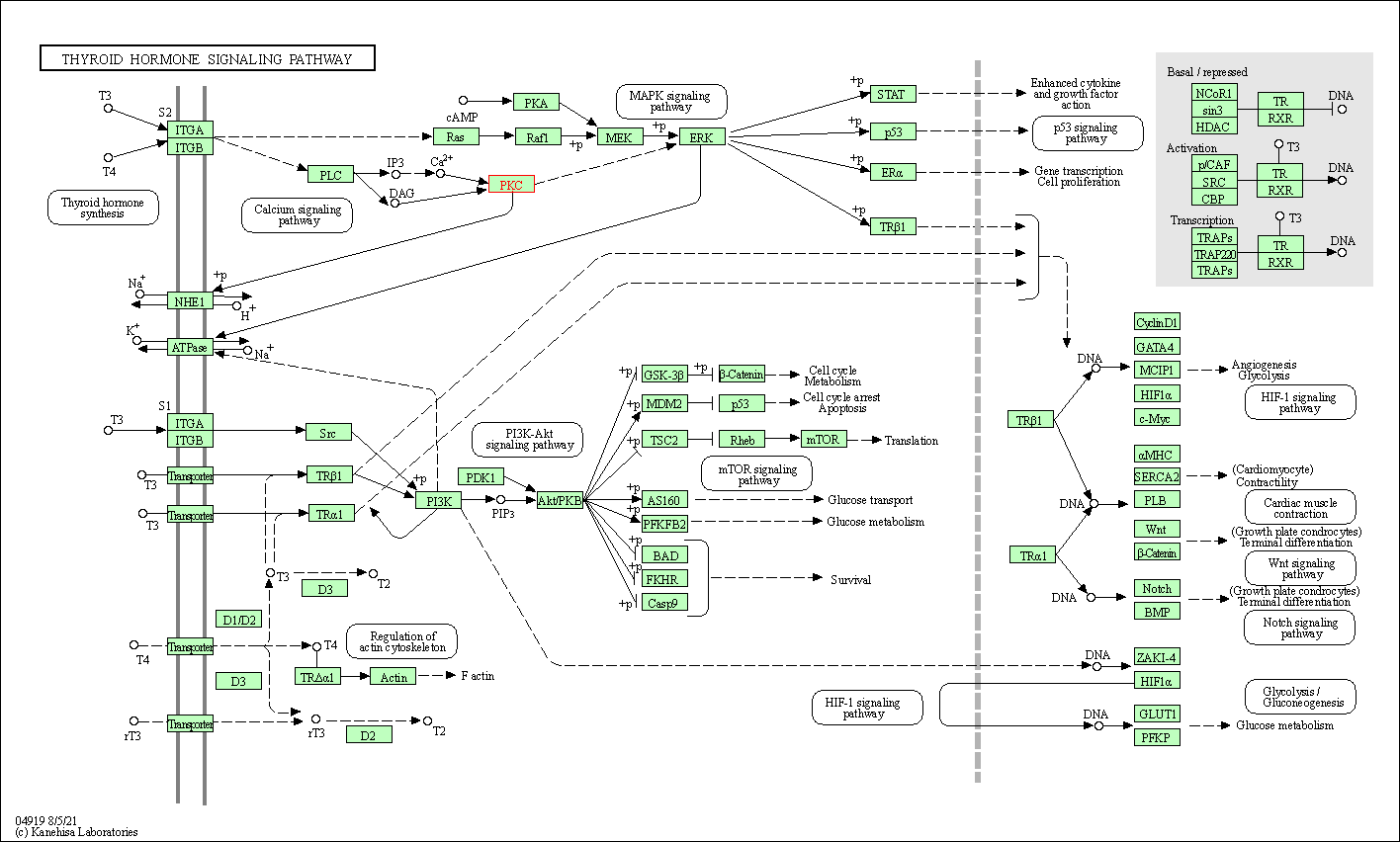
|
| Class: Organismal Systems => Endocrine system | Pathway Hierarchy | ||
| Oxytocin signaling pathway | hsa04921 | Affiliated Target |

|
| Class: Organismal Systems => Endocrine system | Pathway Hierarchy | ||
| Aldosterone synthesis and secretion | hsa04925 | Affiliated Target |
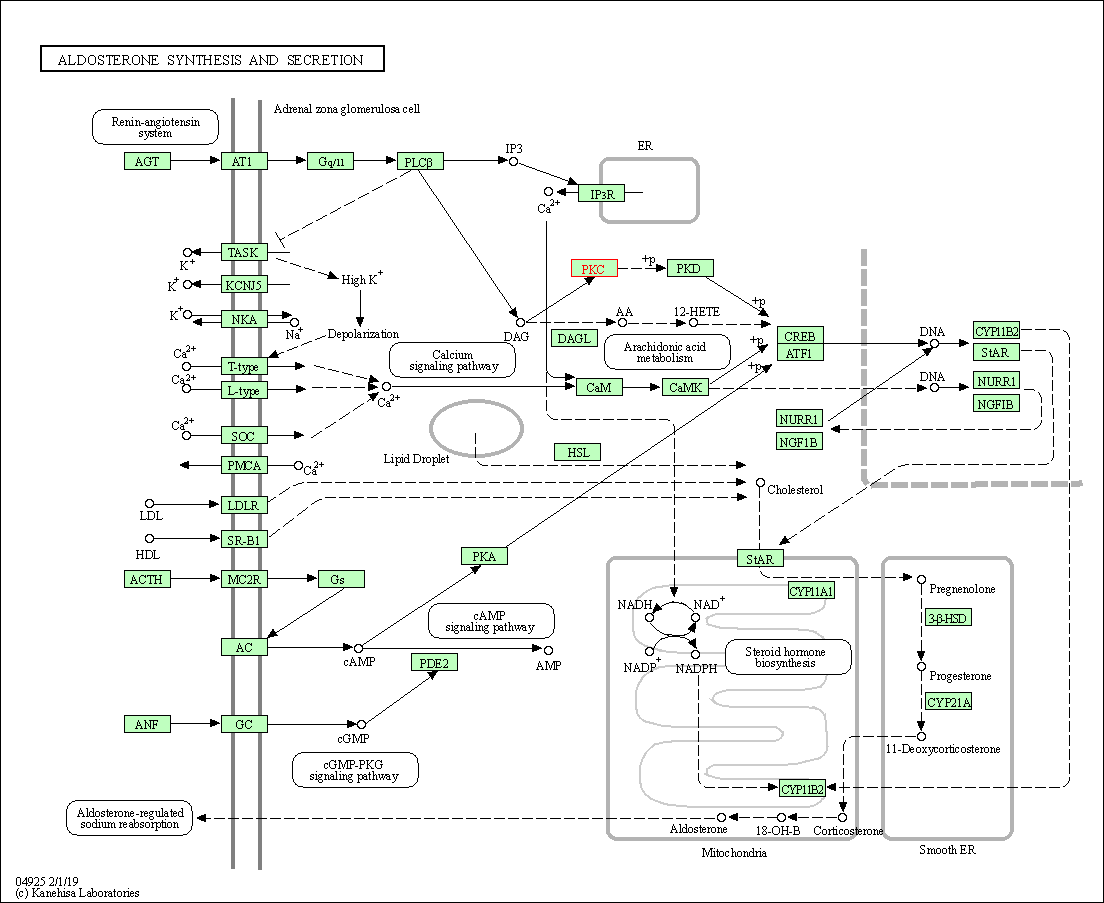
|
| Class: Organismal Systems => Endocrine system | Pathway Hierarchy | ||
| Parathyroid hormone synthesis, secretion and action | hsa04928 | Affiliated Target |
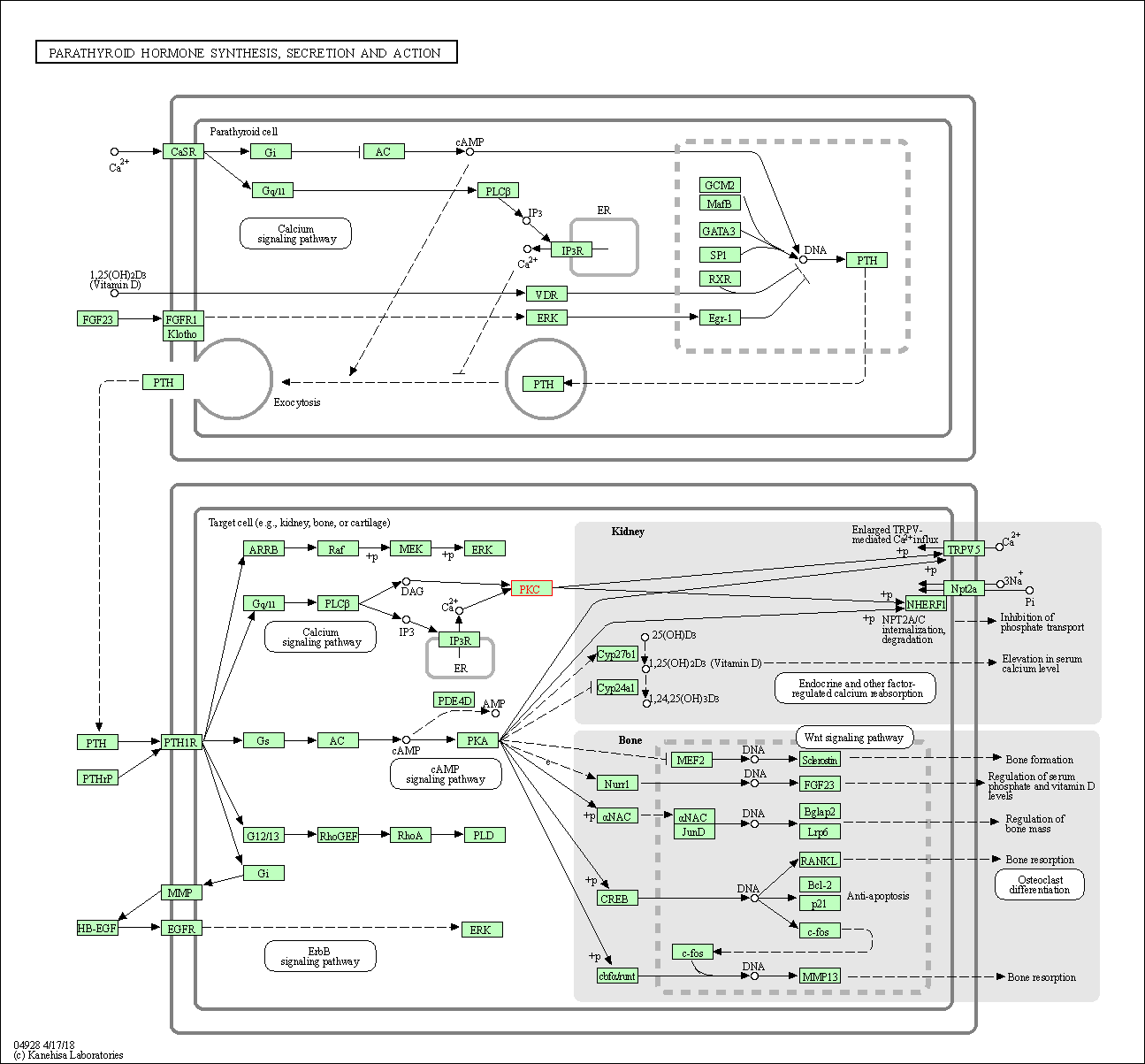
|
| Class: Organismal Systems => Endocrine system | Pathway Hierarchy | ||
| GnRH secretion | hsa04929 | Affiliated Target |

|
| Class: Organismal Systems => Endocrine system | Pathway Hierarchy | ||
| Growth hormone synthesis, secretion and action | hsa04935 | Affiliated Target |
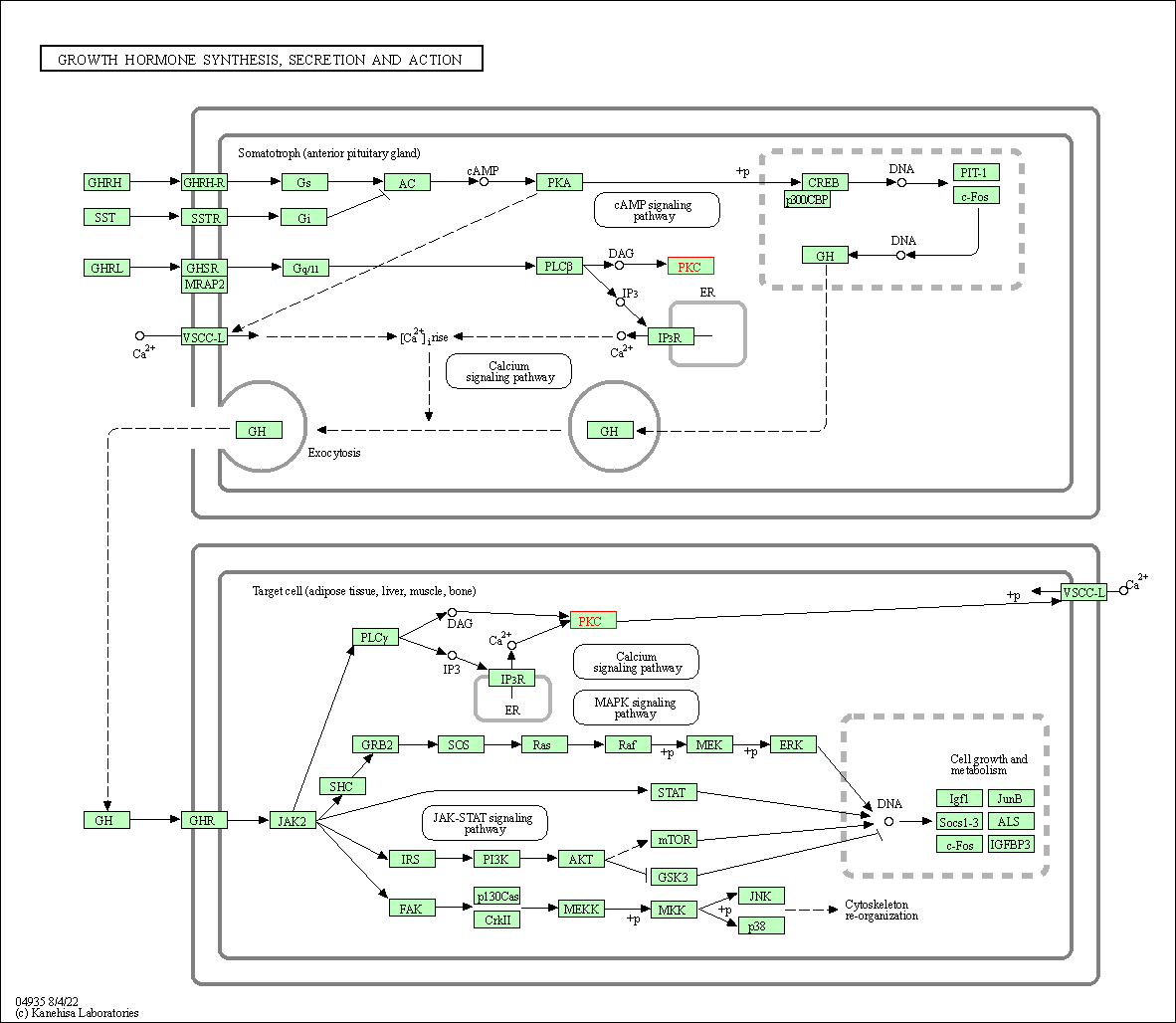
|
| Class: Organismal Systems => Endocrine system | Pathway Hierarchy | ||
| Aldosterone-regulated sodium reabsorption | hsa04960 | Affiliated Target |

|
| Class: Organismal Systems => Excretory system | Pathway Hierarchy | ||
| Endocrine and other factor-regulated calcium reabsorption | hsa04961 | Affiliated Target |
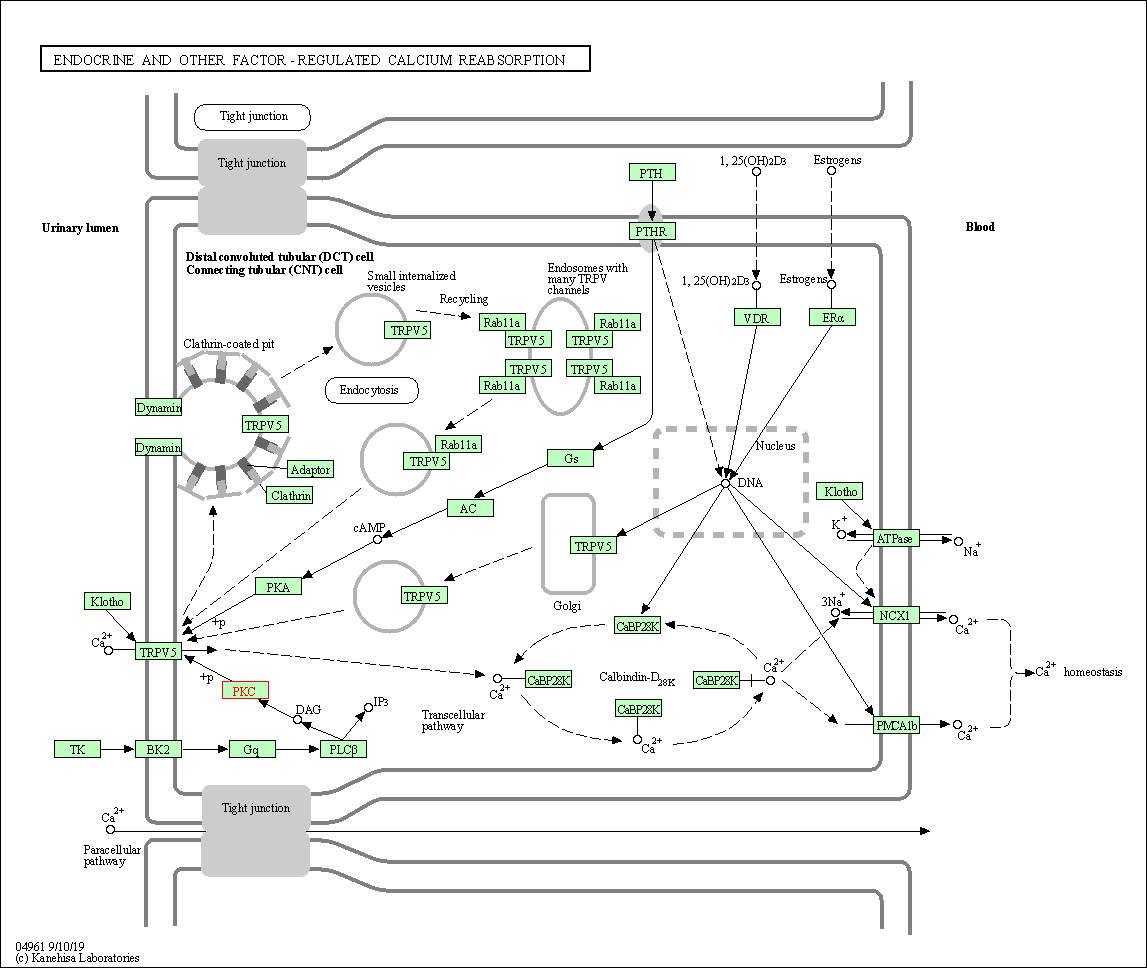
|
| Class: Organismal Systems => Excretory system | Pathway Hierarchy | ||
| Salivary secretion | hsa04970 | Affiliated Target |
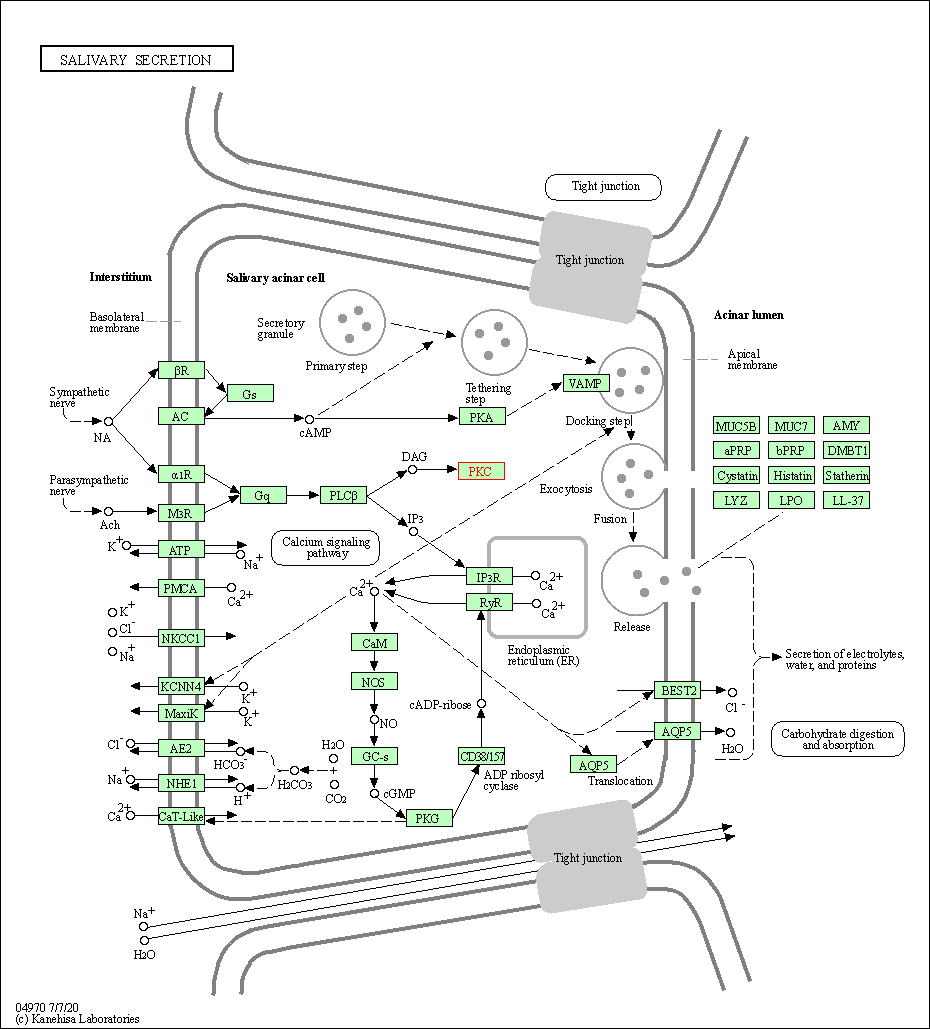
|
| Class: Organismal Systems => Digestive system | Pathway Hierarchy | ||
| Gastric acid secretion | hsa04971 | Affiliated Target |
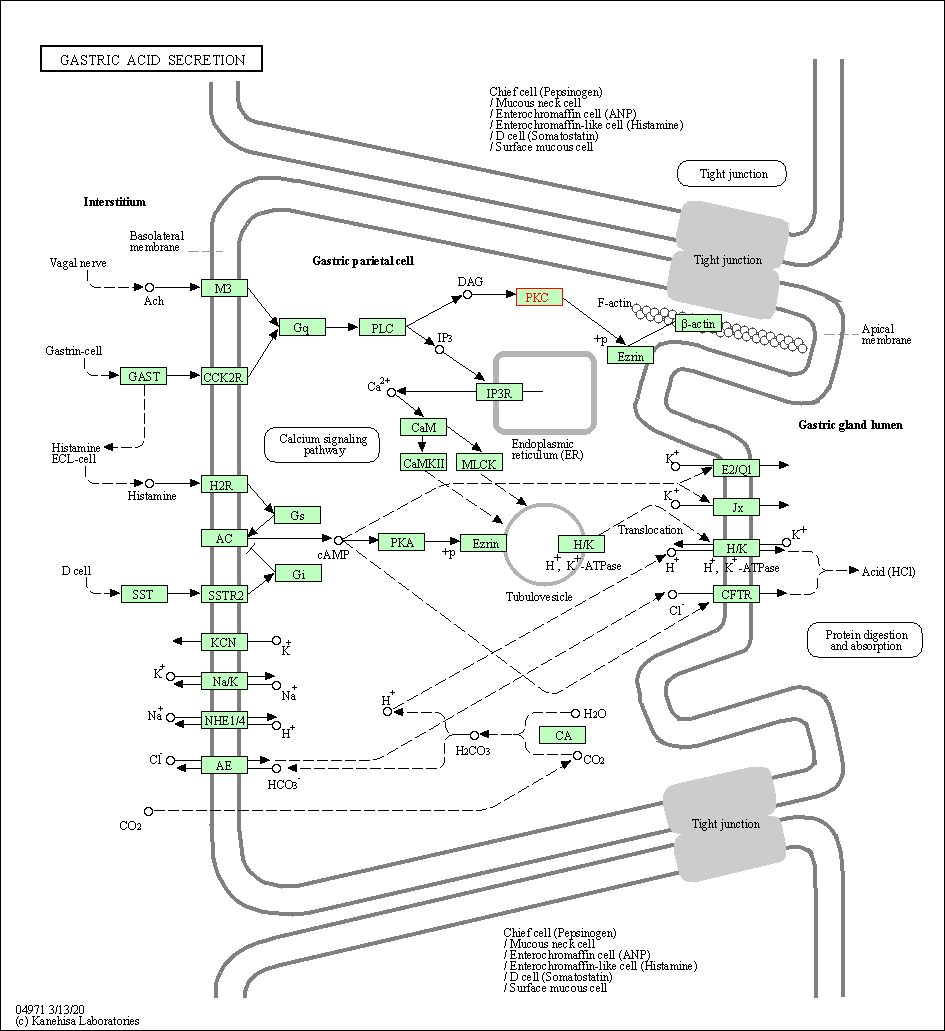
|
| Class: Organismal Systems => Digestive system | Pathway Hierarchy | ||
| Pancreatic secretion | hsa04972 | Affiliated Target |
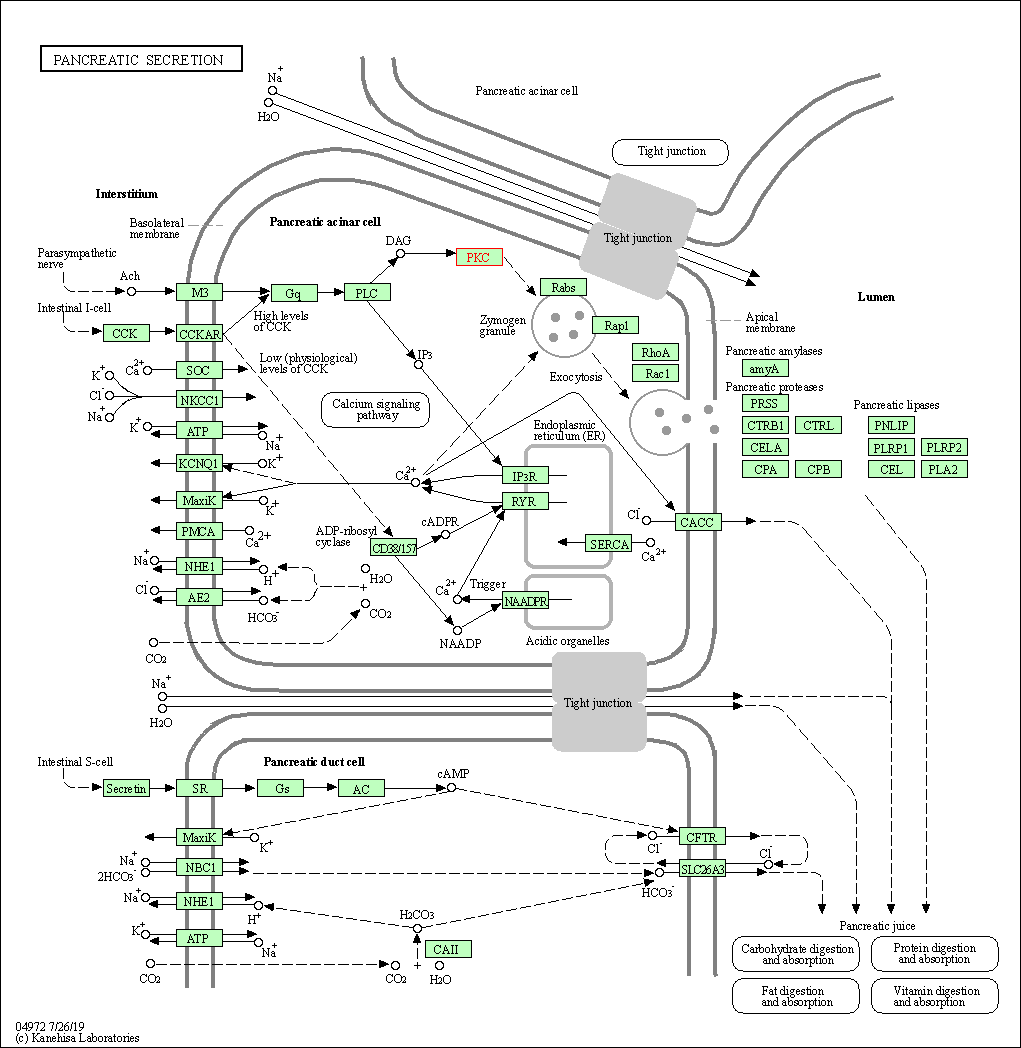
|
| Class: Organismal Systems => Digestive system | Pathway Hierarchy | ||
| Carbohydrate digestion and absorption | hsa04973 | Affiliated Target |
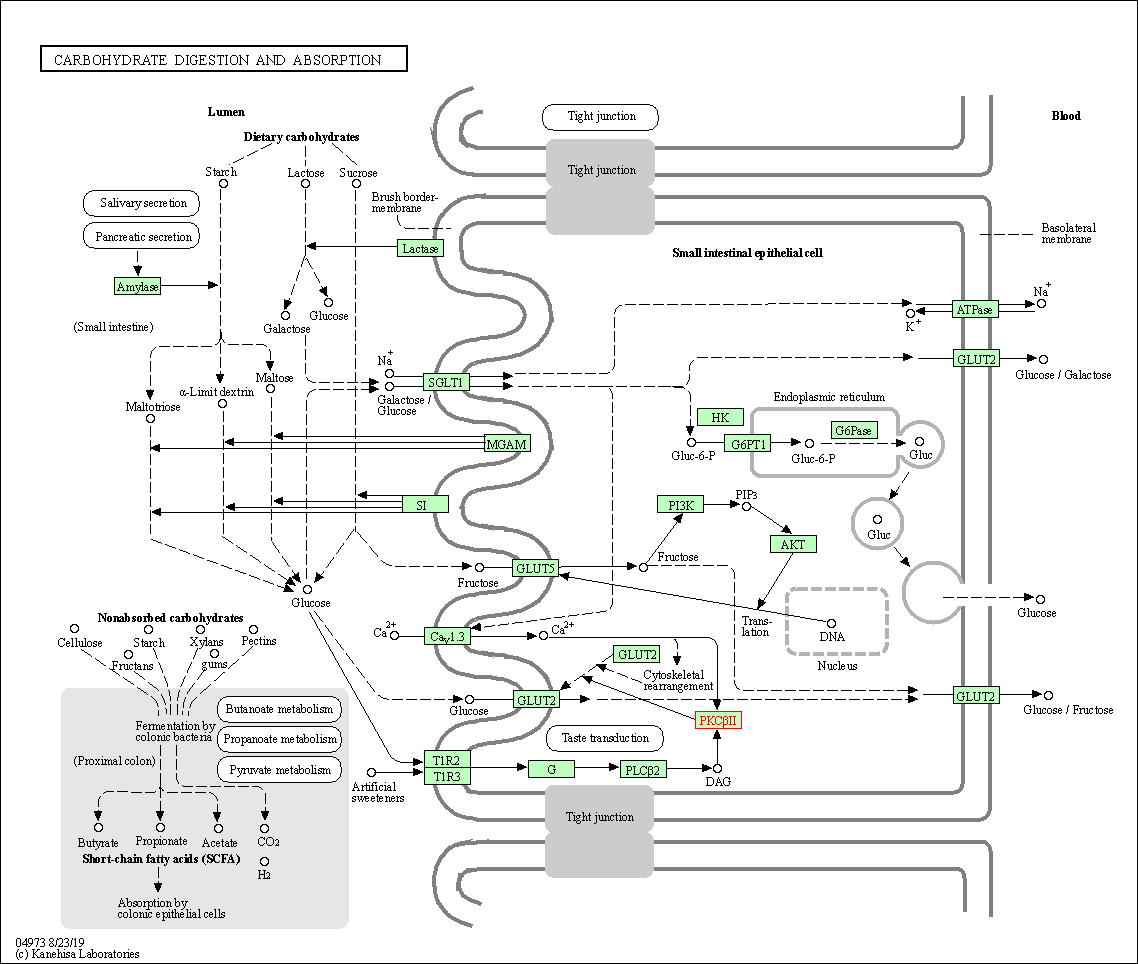
|
| Class: Organismal Systems => Digestive system | Pathway Hierarchy | ||
| Click to Show/Hide the Information of Affiliated Human Pathways | |||
| Degree | 7 | Degree centrality | 7.52E-04 | Betweenness centrality | 6.26E-05 |
|---|---|---|---|---|---|
| Closeness centrality | 2.20E-01 | Radiality | 1.39E+01 | Clustering coefficient | 1.43E-01 |
| Neighborhood connectivity | 4.13E+01 | Topological coefficient | 1.80E-01 | Eccentricity | 12 |
| Download | Click to Download the Full PPI Network of This Target | ||||
| Chemical Structure based Activity Landscape of Target | Top |
|---|---|
| Drug Property Profile of Target | Top | |
|---|---|---|
| (1) Molecular Weight (mw) based Drug Clustering | (2) Octanol/Water Partition Coefficient (xlogp) based Drug Clustering | |
|
|
||
| (3) Hydrogen Bond Donor Count (hbonddonor) based Drug Clustering | (4) Hydrogen Bond Acceptor Count (hbondacc) based Drug Clustering | |
|
|
||
| (5) Rotatable Bond Count (rotbonds) based Drug Clustering | (6) Topological Polar Surface Area (polararea) based Drug Clustering | |
|
|
||
| "RO5" indicates the cutoff set by lipinski's rule of five; "D123AB" colored in GREEN denotes the no violation of any cutoff in lipinski's rule of five; "D123AB" colored in PURPLE refers to the violation of only one cutoff in lipinski's rule of five; "D123AB" colored in BLACK represents the violation of more than one cutoffs in lipinski's rule of five | ||
| Co-Targets | Top | |||||
|---|---|---|---|---|---|---|
| Co-Targets | ||||||
| Target Poor or Non Binders | Top | |||||
|---|---|---|---|---|---|---|
| Target Poor or Non Binders | ||||||
| Target Regulators | Top | |||||
|---|---|---|---|---|---|---|
| Target-regulating microRNAs | ||||||
| Target-interacting Proteins | ||||||
| Target-Related Models and Studies | Top | |||||
|---|---|---|---|---|---|---|
| Target Validation | ||||||
| References | Top | |||||
|---|---|---|---|---|---|---|
| REF 1 | The oral protein-kinase C beta inhibitor enzastaurin (LY317615) suppresses signalling through the AKT pathway, inhibits proliferation and induces apoptosis in multiple myeloma cell lines. Leuk Lymphoma. 2008 Jul;49(7):1374-83. | |||||
| REF 2 | URL: http://www.guidetopharmacology.org Nucleic Acids Res. 2015 Oct 12. pii: gkv1037. The IUPHAR/BPS Guide to PHARMACOLOGY in 2016: towards curated quantitative interactions between 1300 protein targets and 6000 ligands. (Ligand id: 5693). | |||||
| REF 3 | Emerging therapies for multiple myeloma. Expert Opin Emerg Drugs. 2009 Mar;14(1):99-127. | |||||
| REF 4 | Ruboxistaurin: LY 333531. Drugs R D. 2007;8(3):193-9. | |||||
| REF 5 | ClinicalTrials.gov (NCT00482976) Effect of LY333531 on Vascular and Neural Functions. U.S. National Institutes of Health. | |||||
| REF 6 | Emerging drugs for psoriasis. Expert Opin Emerg Drugs. 2009 Mar;14(1):145-63. | |||||
| REF 7 | ClinicalTrials.gov (NCT03492125) A Study Of The Selective PKC-beta Inhibitor MS- 553. U.S. National Institutes of Health. | |||||
| REF 8 | Trusted, scientifically sound profiles of drug programs, clinical trials, safety reports, and company deals, written by scientists. Springer. 2015. Adis Insight (drug id 800002311) | |||||
| REF 9 | Potential new medical therapies for diabetic retinopathy: protein kinase C inhibitors. Am J Ophthalmol. 2002 May;133(5):693-8. | |||||
| REF 10 | Evaluation of differential hypoxic cytotoxicity and electrochemical studies of nitro 5-deazaflavins, Bioorg. Med. Chem. Lett. 5(18):2155-2160 (1995). | |||||
| REF 11 | Bisindolylmaleimide inhibitors of protein kinase C. Further conformational restriction of a tertiary amine side chain, Bioorg. Med. Chem. Lett. 4(11):1303-1308 (1994). | |||||
| REF 12 | (-)-Cercosporamide derivatives as novel antihyperglycemic agents. Bioorg Med Chem Lett. 2009 Feb 1;19(3):724-6. | |||||
| REF 13 | Multivariate analysis by the minimum spanning tree method of the structural determinants of diphenylethylenes and triphenylacrylonitriles implicate... J Med Chem. 1992 Feb 7;35(3):573-83. | |||||
| REF 14 | Inhibition of protein kinase C mu by various inhibitors. Differentiation from protein kinase c isoenzymes. FEBS Lett. 1996 Aug 26;392(2):77-80. | |||||
| REF 15 | Synthesis of anilino-monoindolylmaleimides as potent and selective PKCbeta inhibitors. Bioorg Med Chem Lett. 2004 Oct 18;14(20):5171-4. | |||||
| REF 16 | (S)-13-[(dimethylamino)methyl]-10,11,14,15-tetrahydro-4,9:16, 21-dimetheno-1H, 13H-dibenzo[e,k]pyrrolo[3,4-h][1,4,13]oxadiazacyclohexadecene-1,3(2H... J Med Chem. 1996 Jul 5;39(14):2664-71. | |||||
| REF 17 | How many drug targets are there Nat Rev Drug Discov. 2006 Dec;5(12):993-6. | |||||
| REF 18 | A nonpromoting phorbol from the samoan medicinal plant Homalanthus nutans inhibits cell killing by HIV-1. J Med Chem. 1992 May 29;35(11):1978-86. | |||||
| REF 19 | Tannins as selective inhibitors of protein kinase C, Bioorg. Med. Chem. Lett. 2(3):239-244 (1992). | |||||
| REF 20 | Inhibitors of protein kinase C. 1. 2,3-Bisarylmaleimides. J Med Chem. 1992 Jan;35(1):177-84. | |||||
| REF 21 | Novel protein kinase C inhibitors: synthesis and PKC inhibition of beta-substituted polythiophene derivatives. Bioorg Med Chem Lett. 1999 Aug 2;9(15):2279-82. | |||||
| REF 22 | Structure of the catalytic domain of human protein kinase C beta II complexed with a bisindolylmaleimide inhibitor. Biochemistry. 2006 Nov 28;45(47):13970-81. | |||||
If You Find Any Error in Data or Bug in Web Service, Please Kindly Report It to Dr. Zhou and Dr. Zhang.

